FUNCTIONAL STYLES IN MODERN ENGLISH N. P. Izotova,
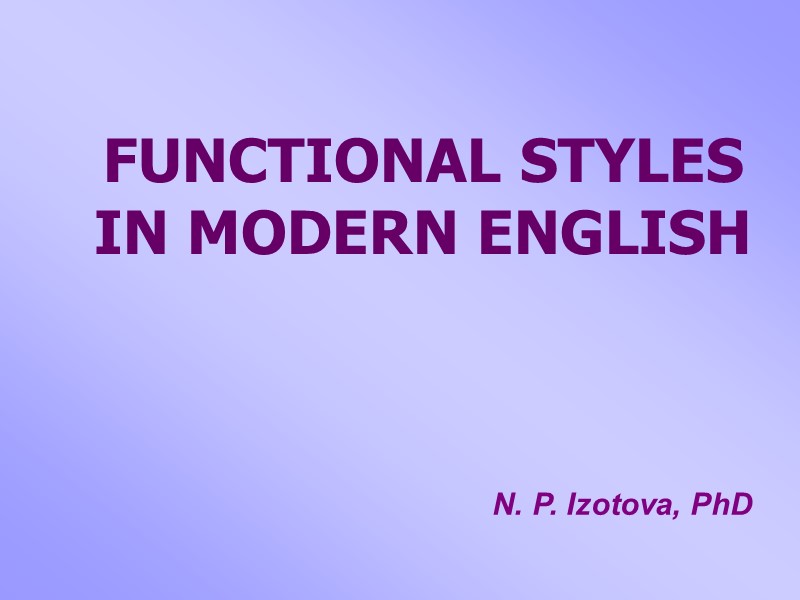
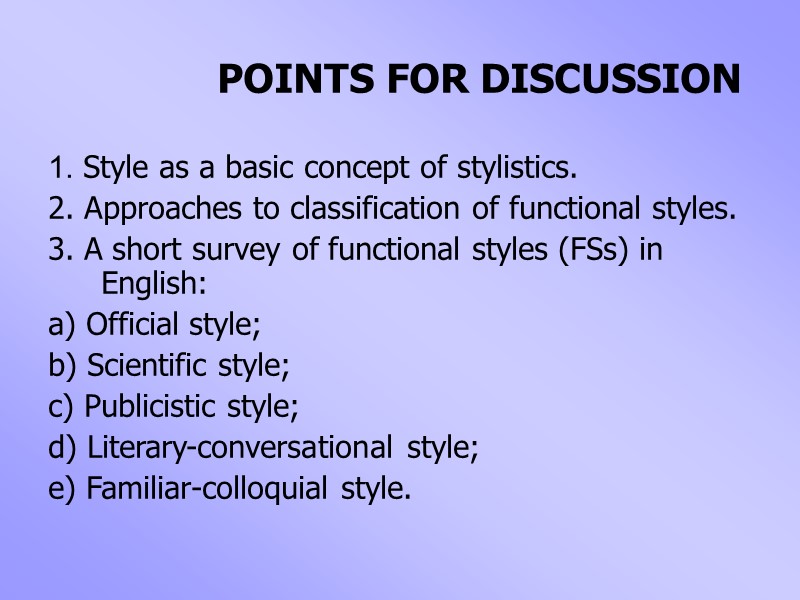
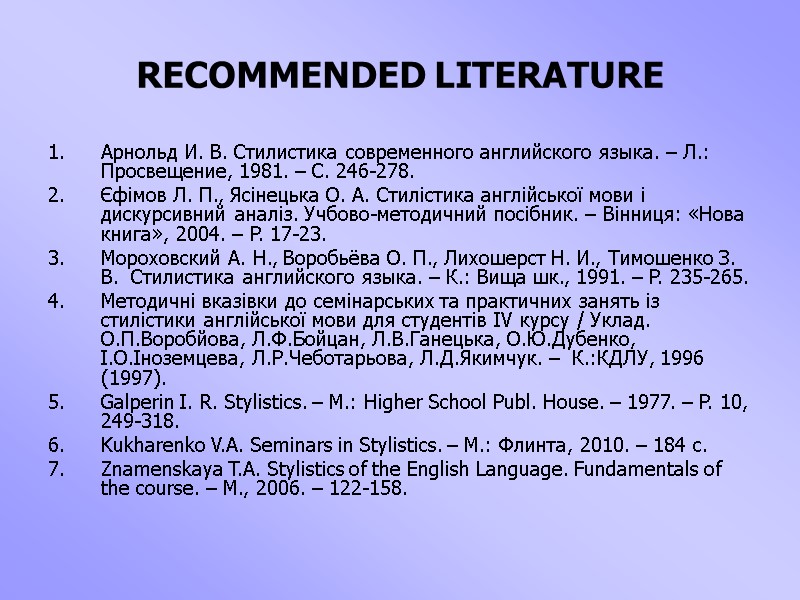
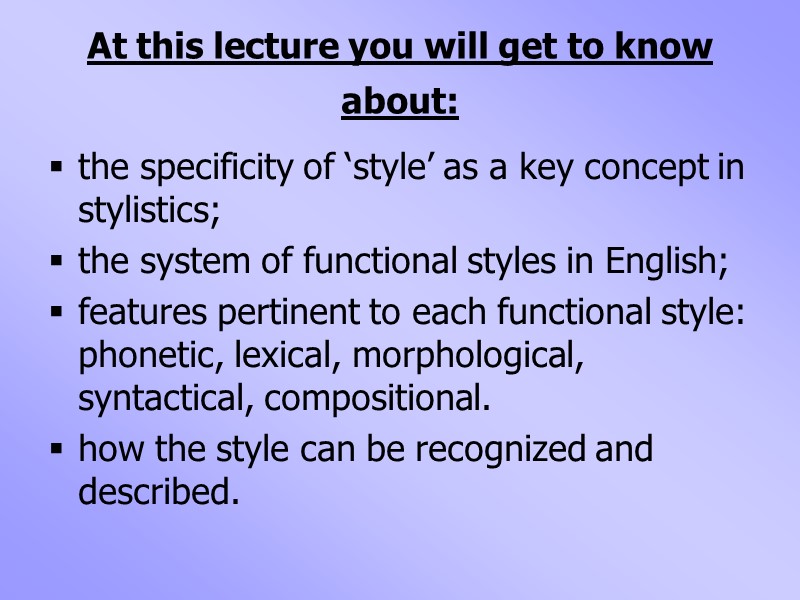
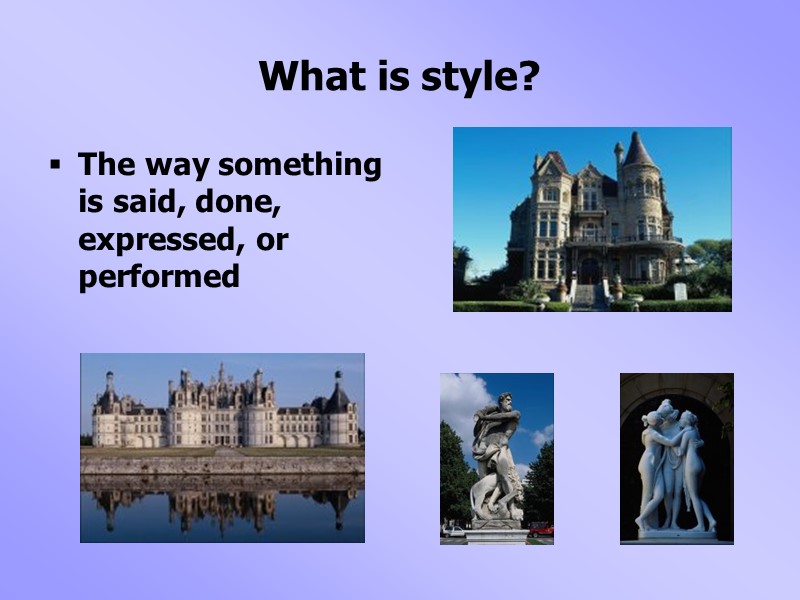
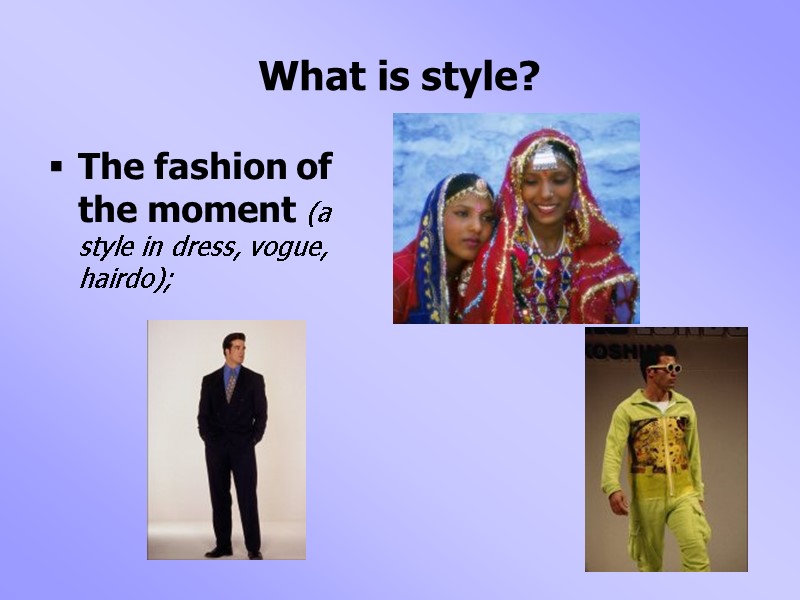
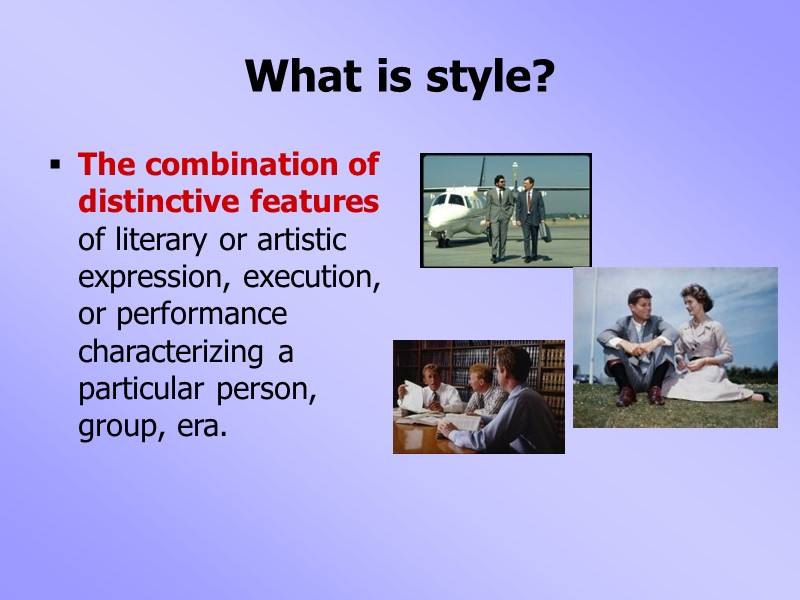
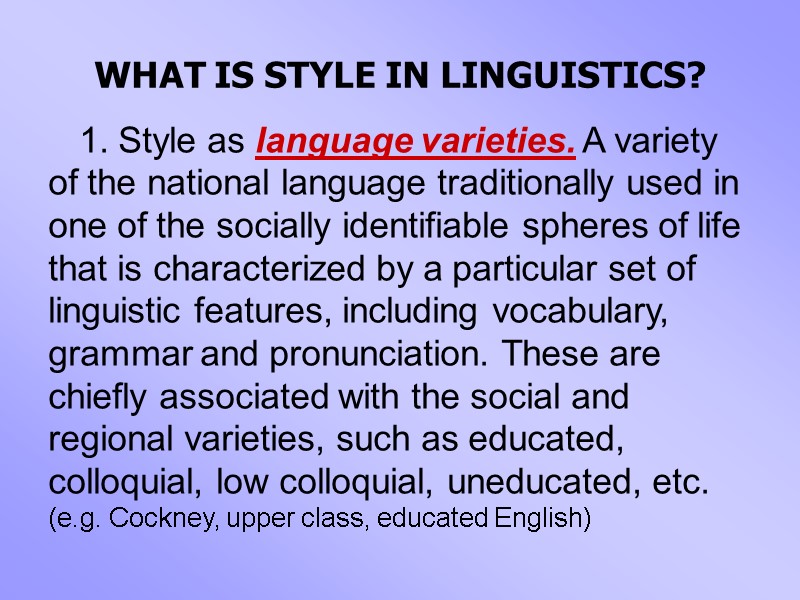
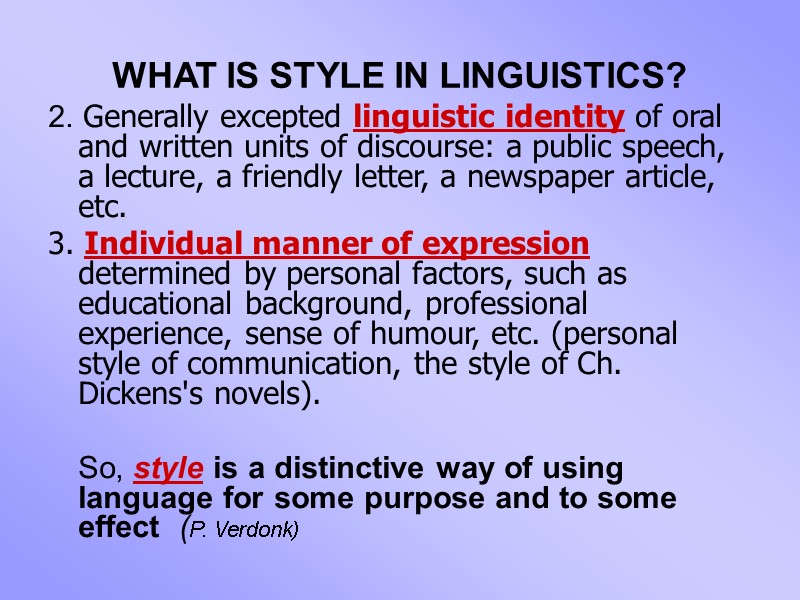
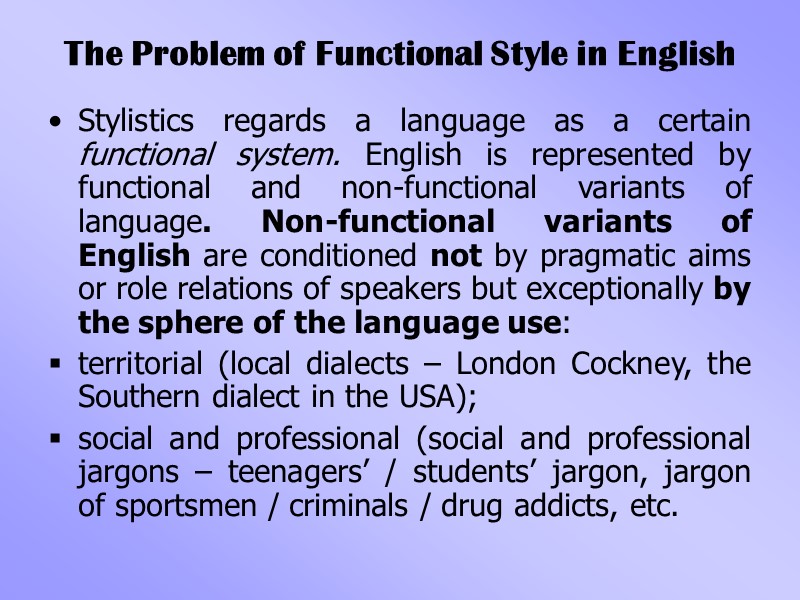
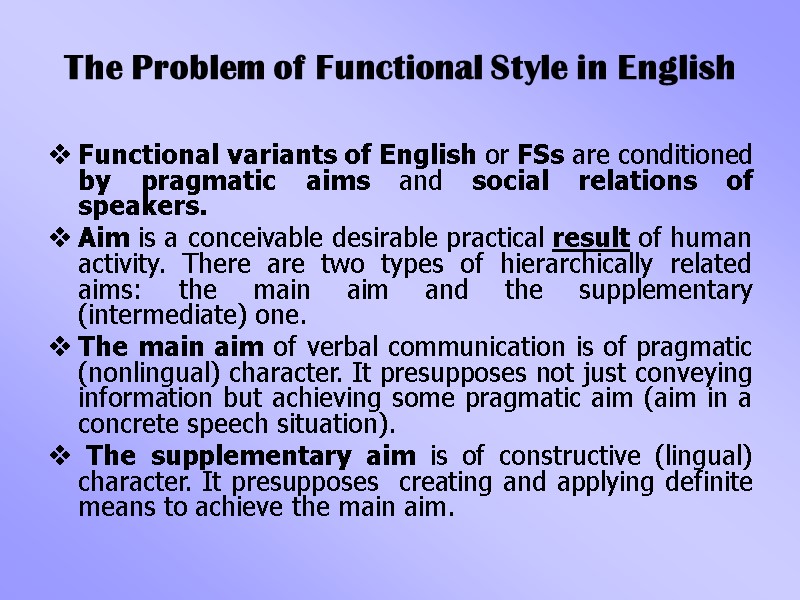
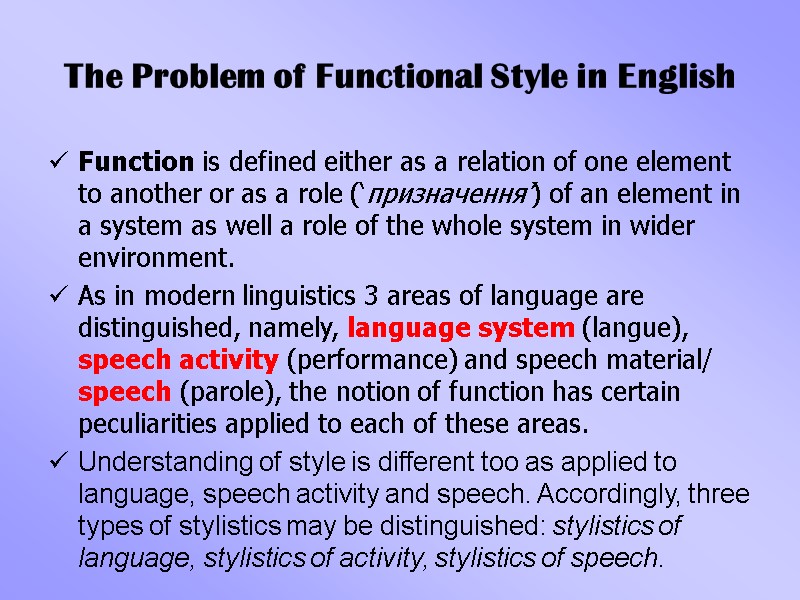
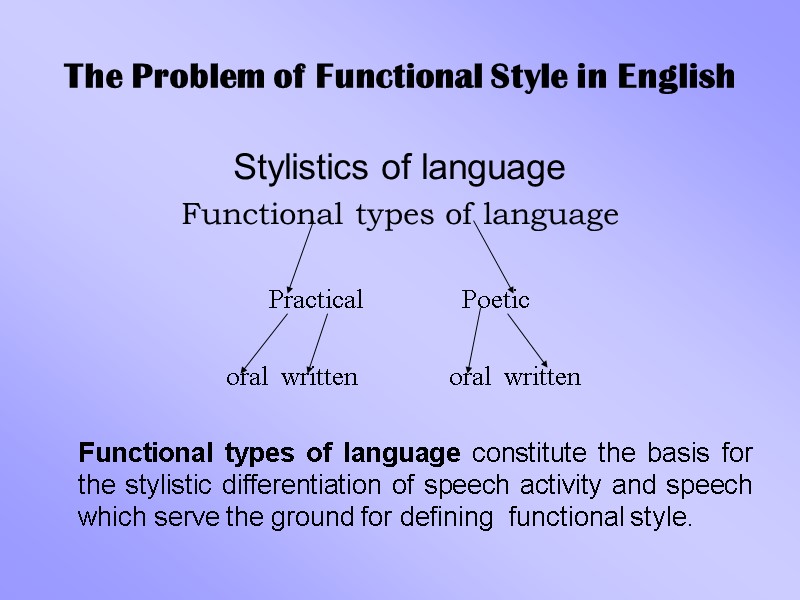
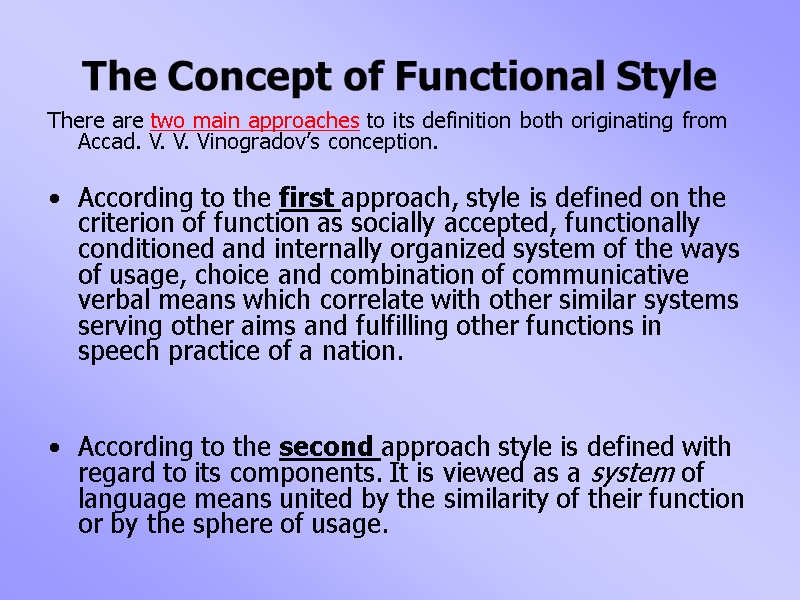
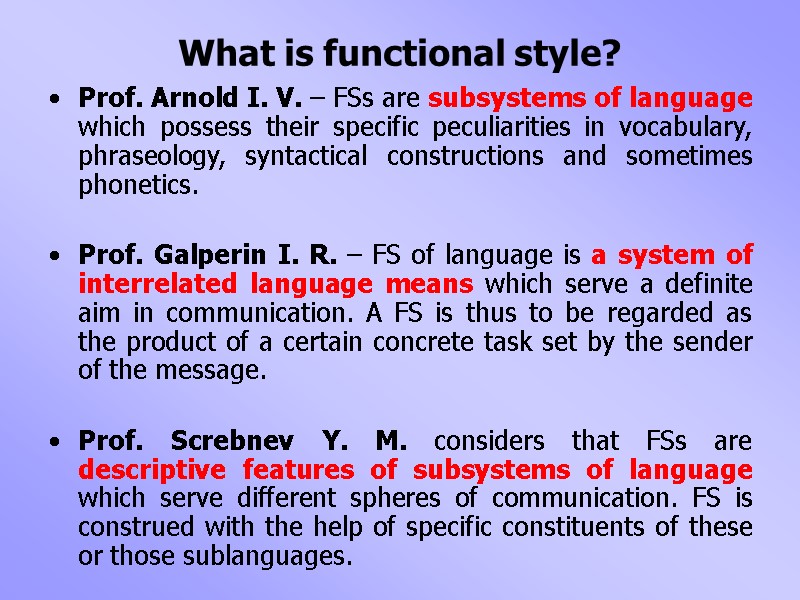
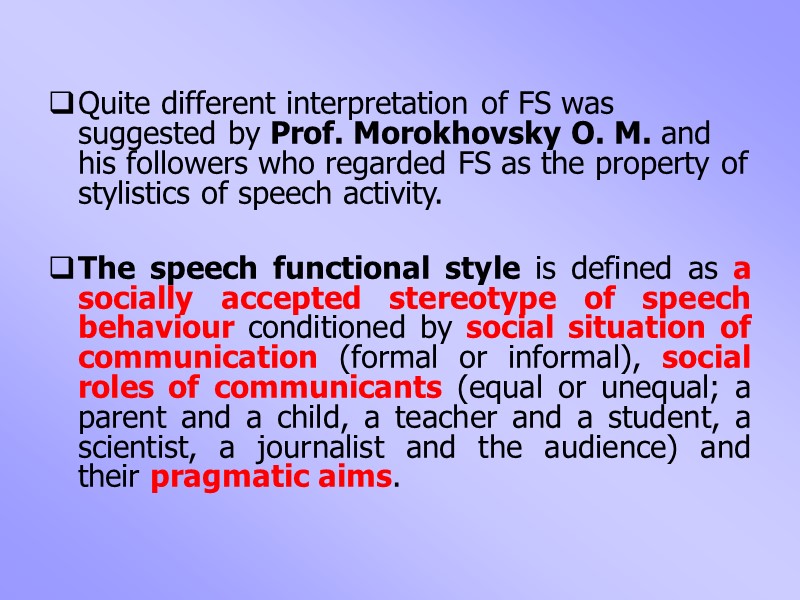
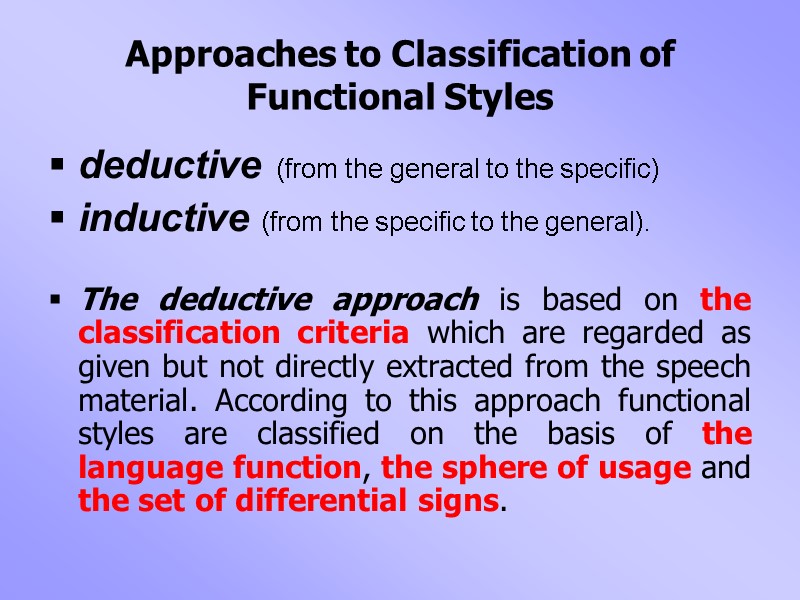
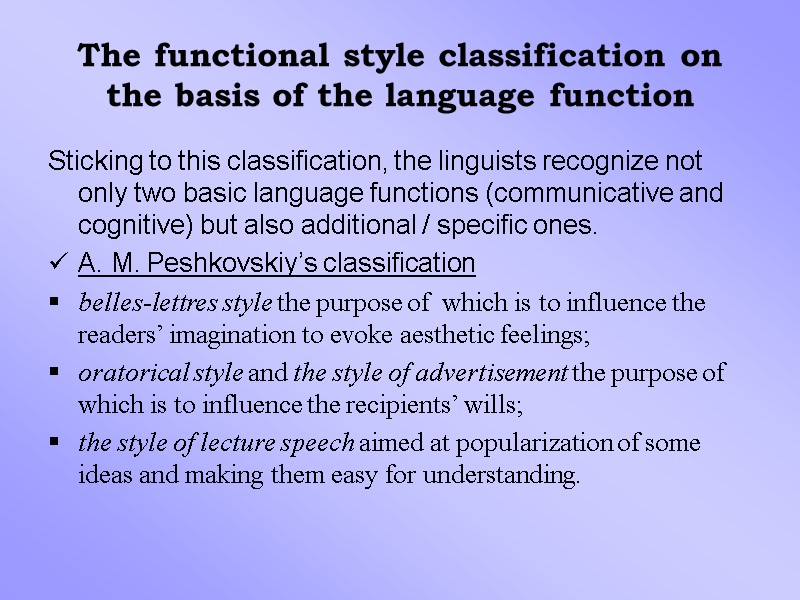
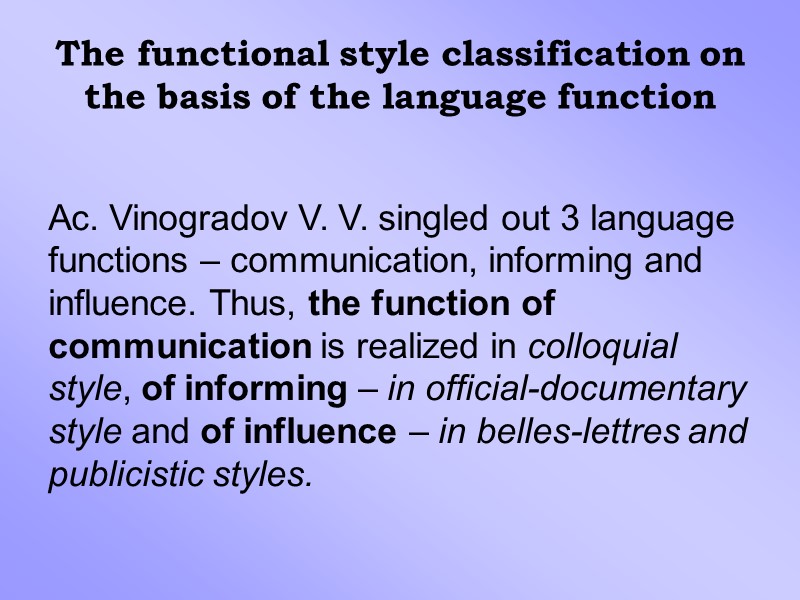
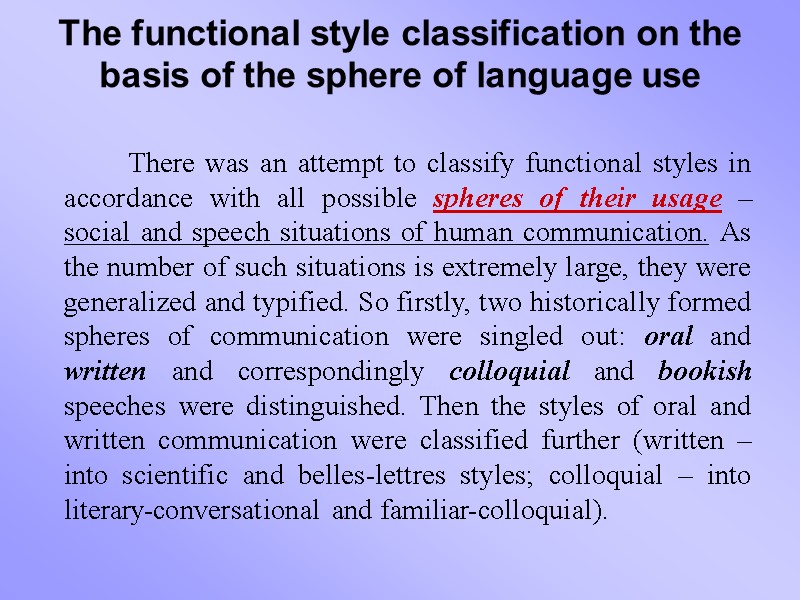
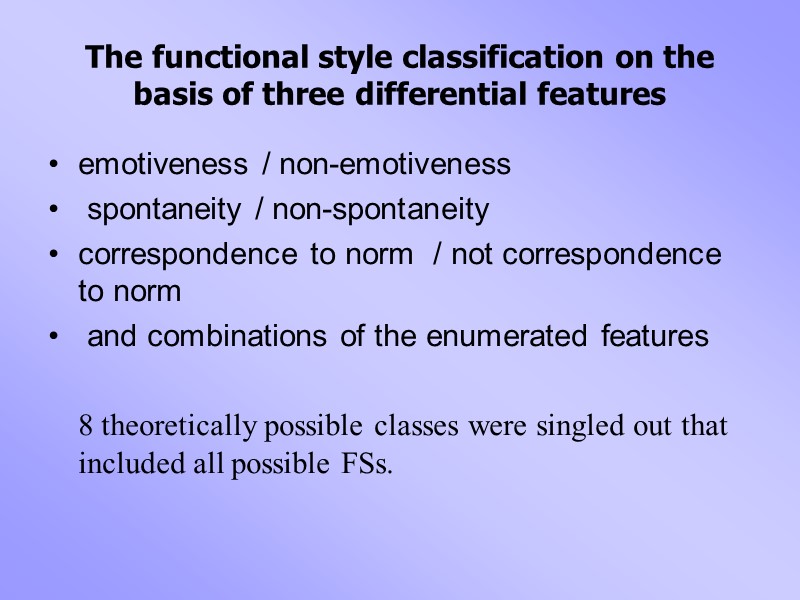
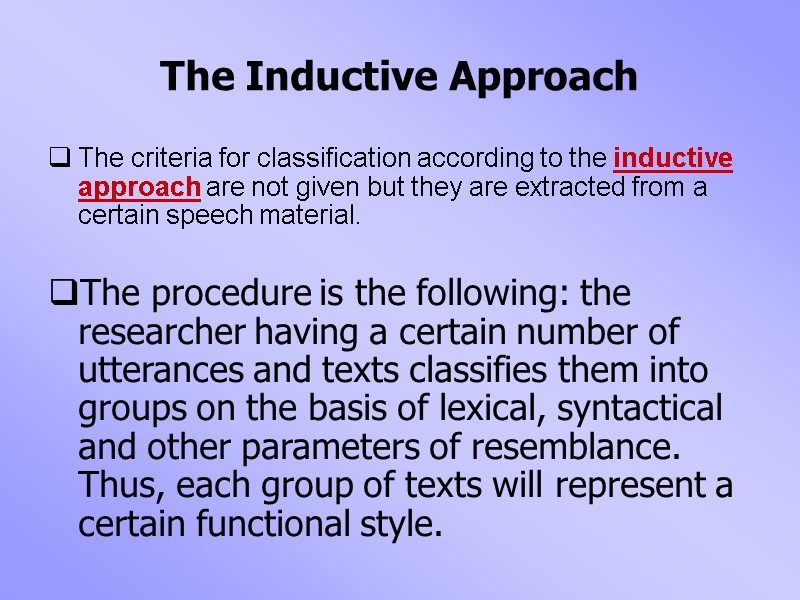
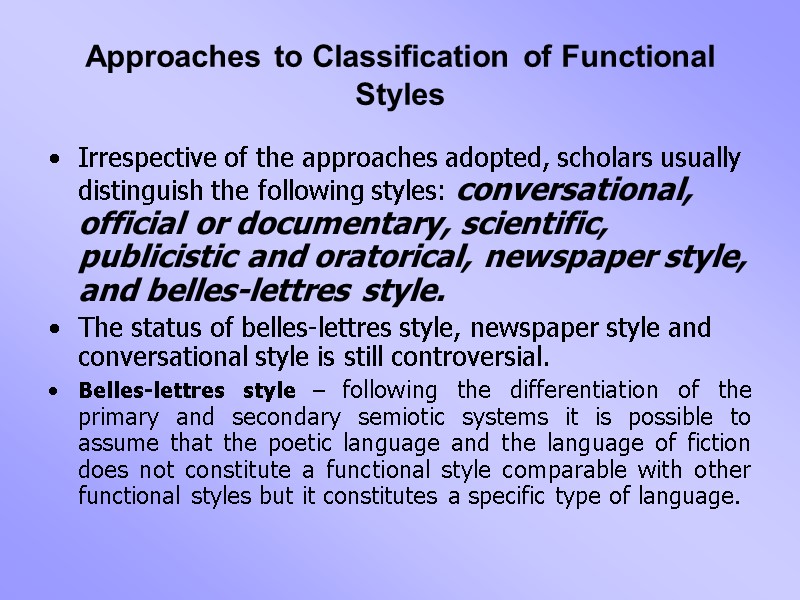
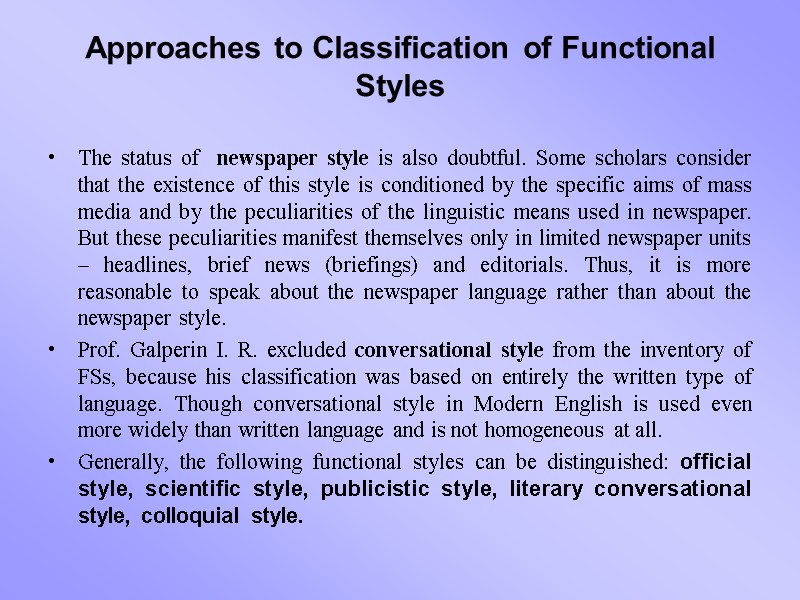
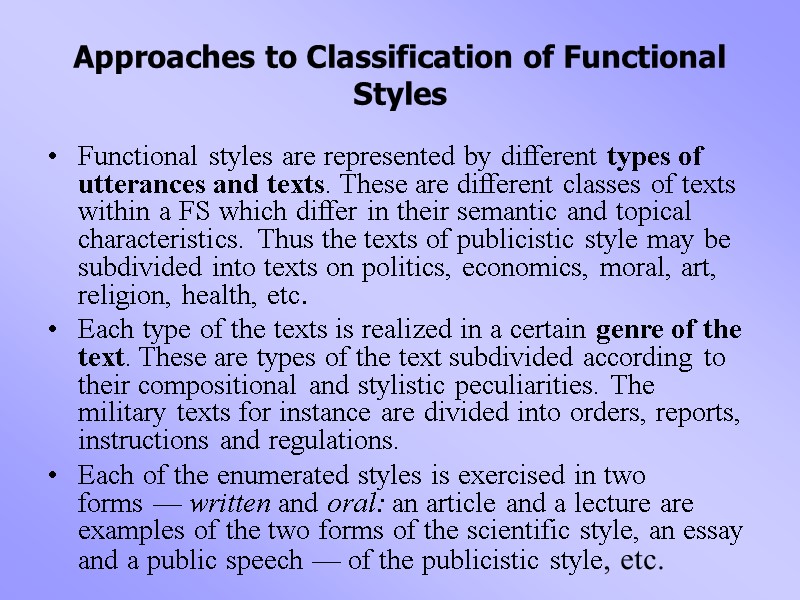
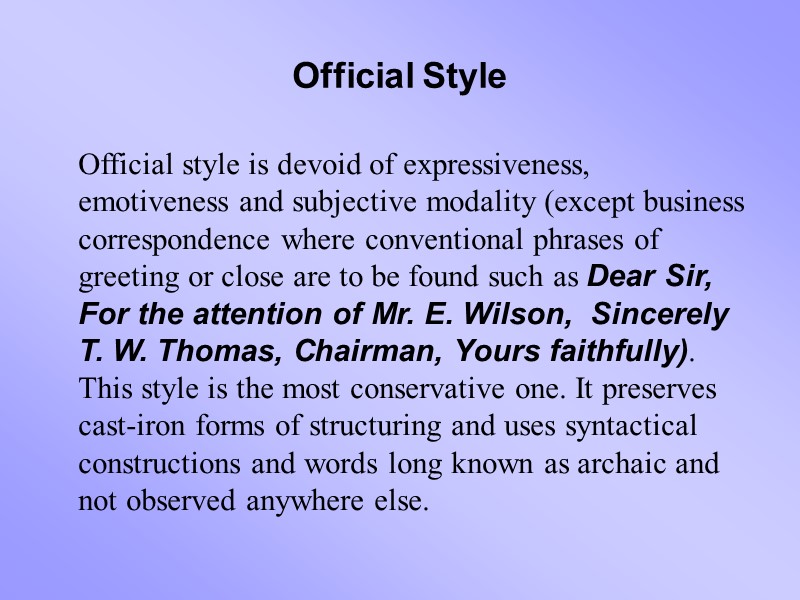
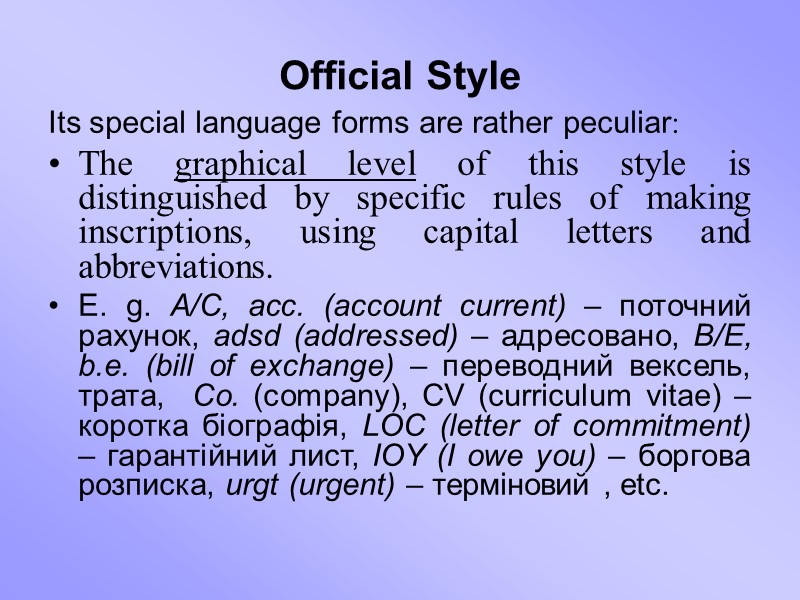
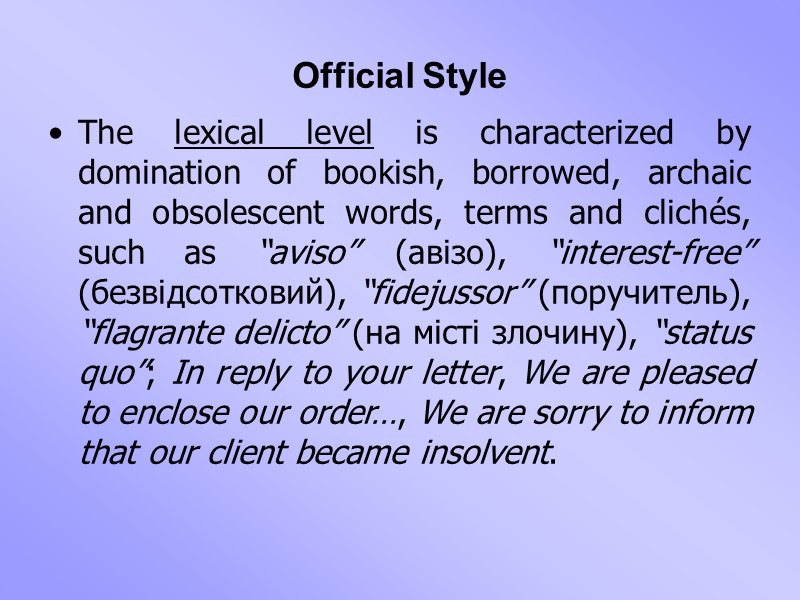
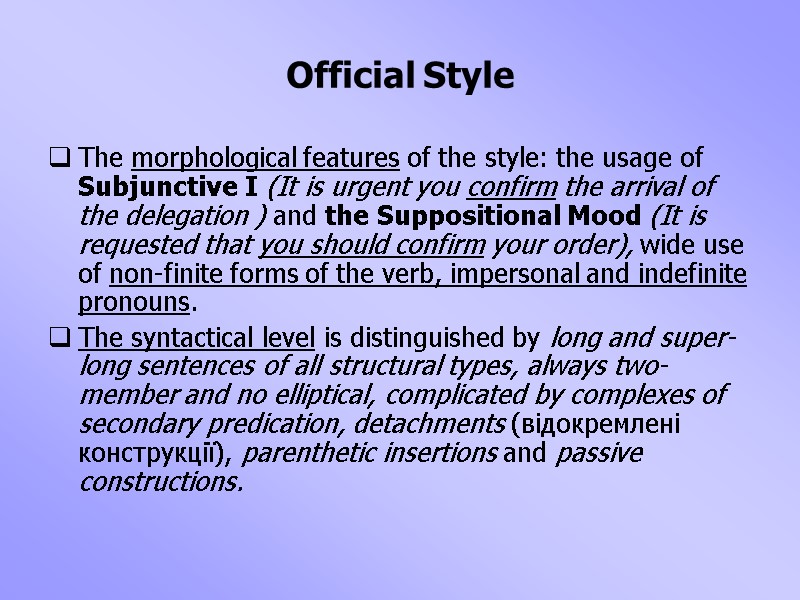
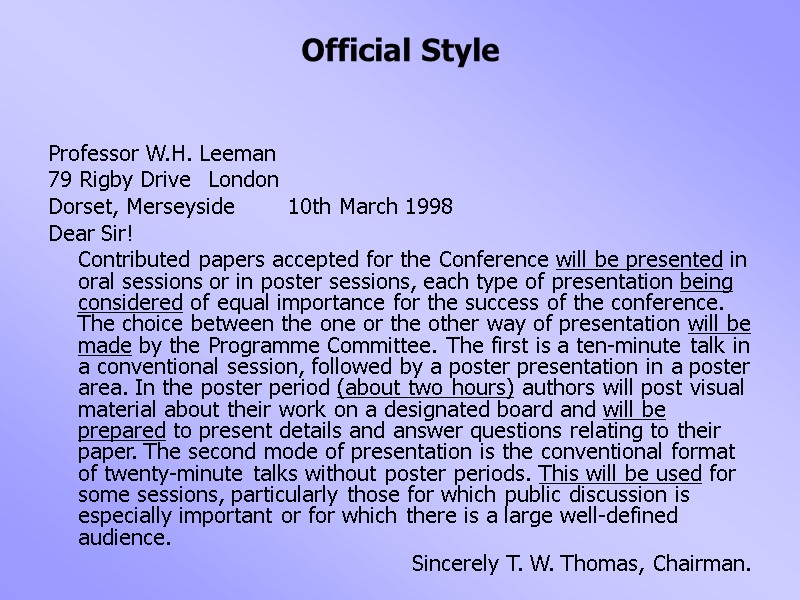
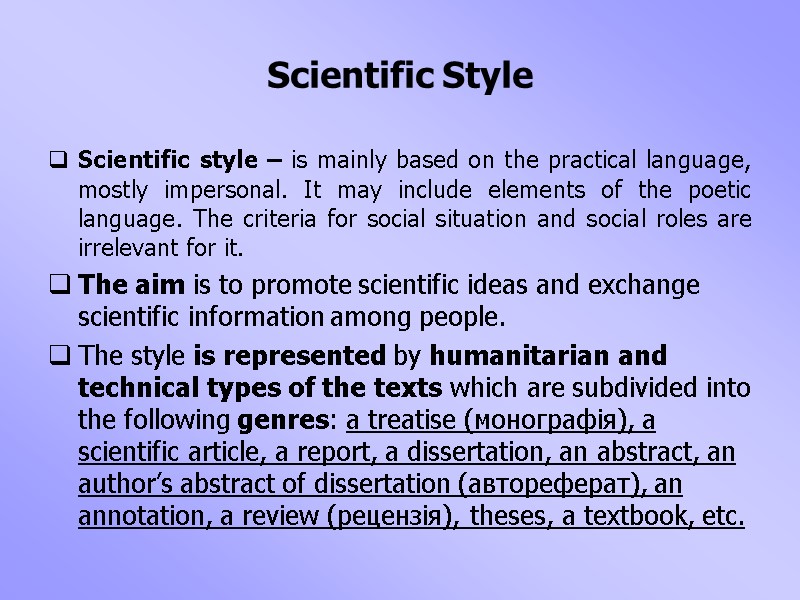
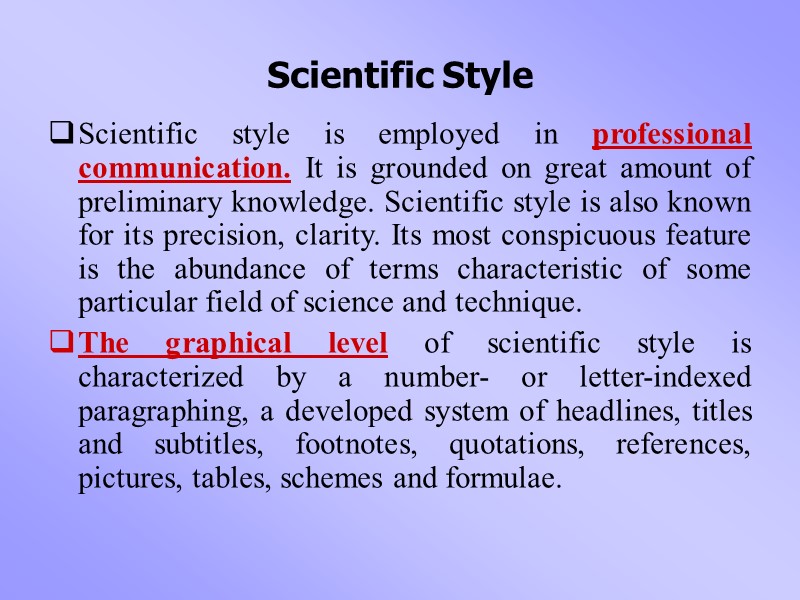
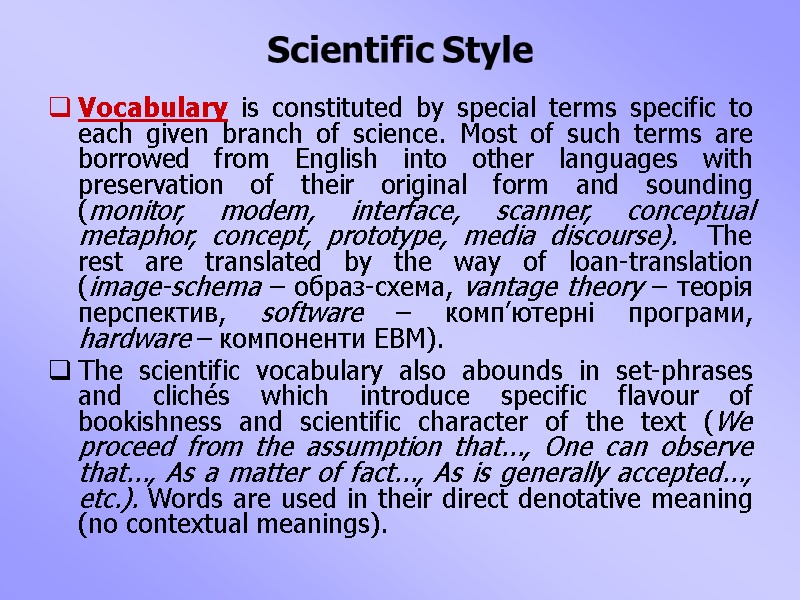
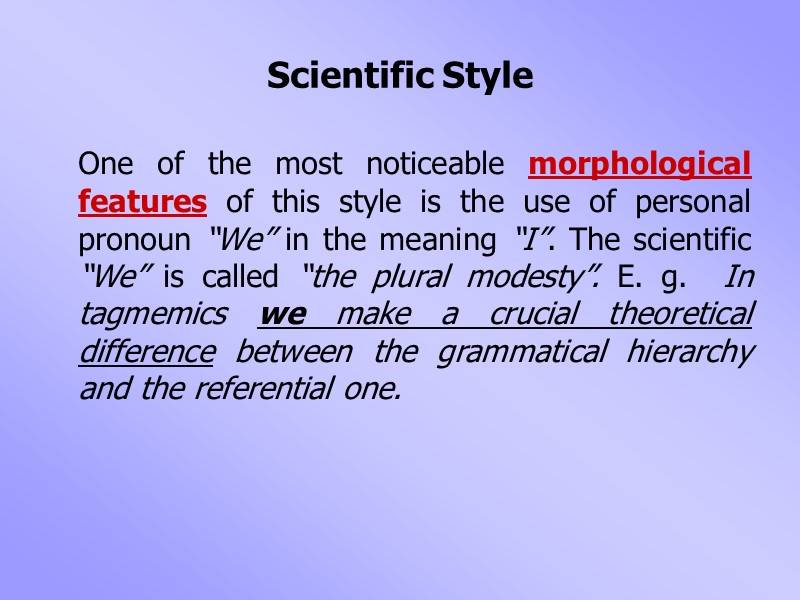
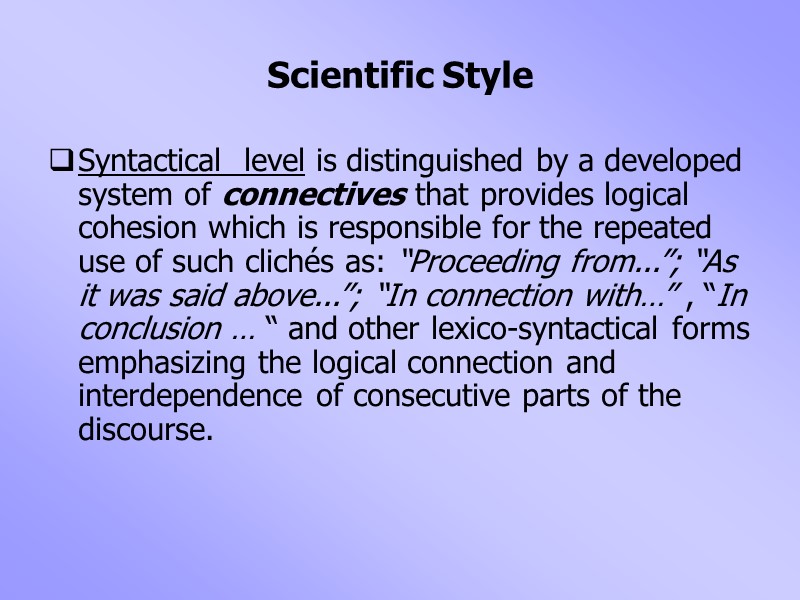
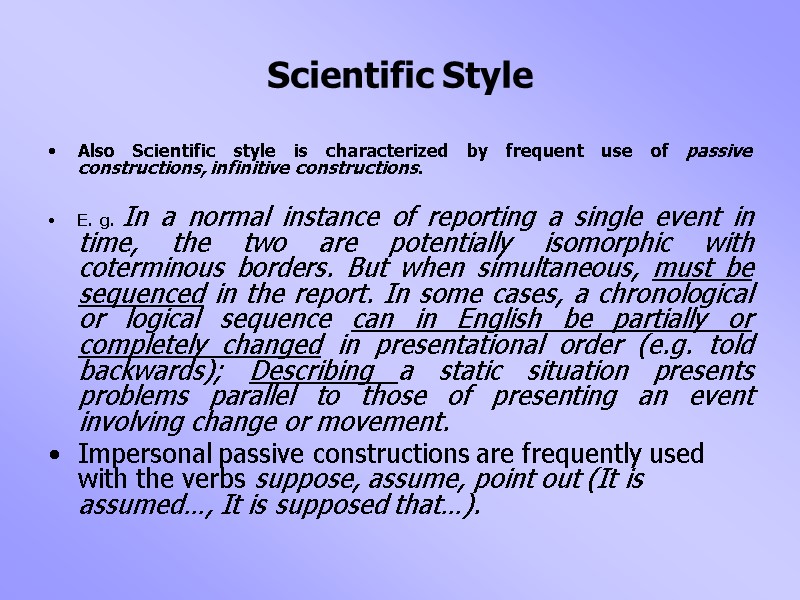
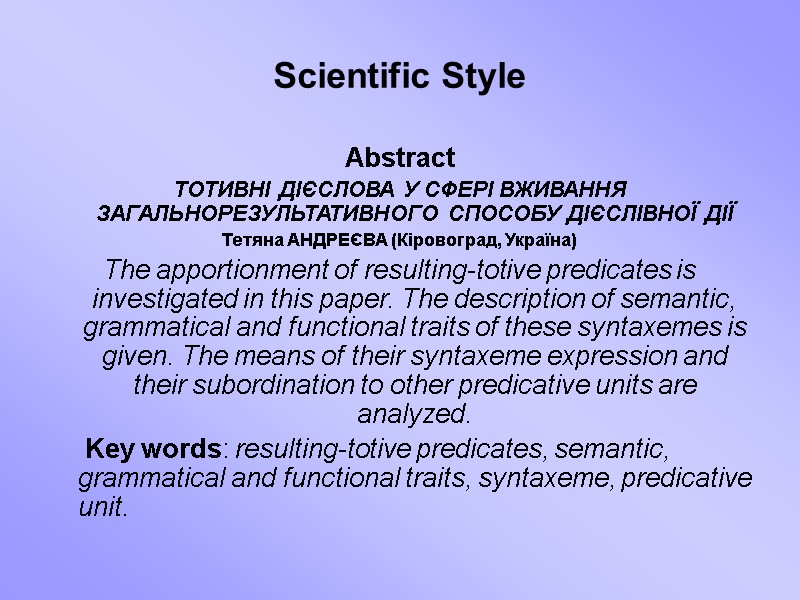
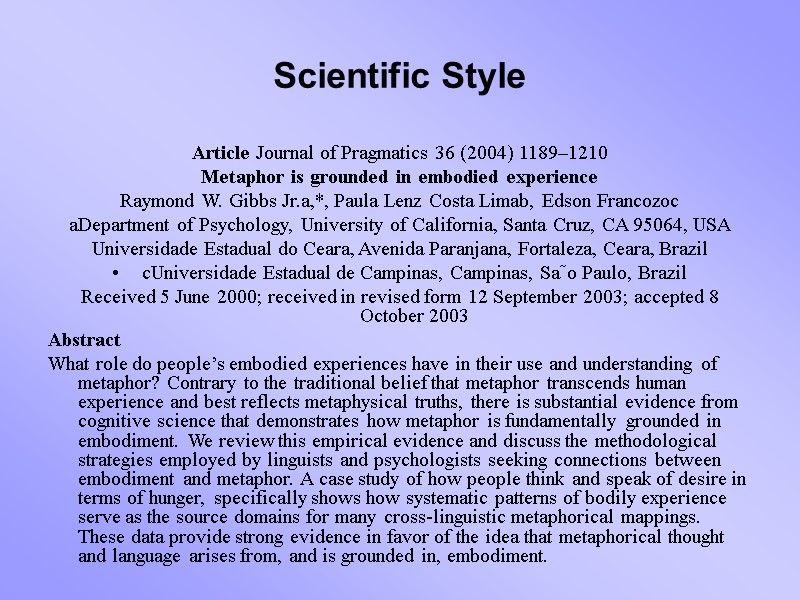
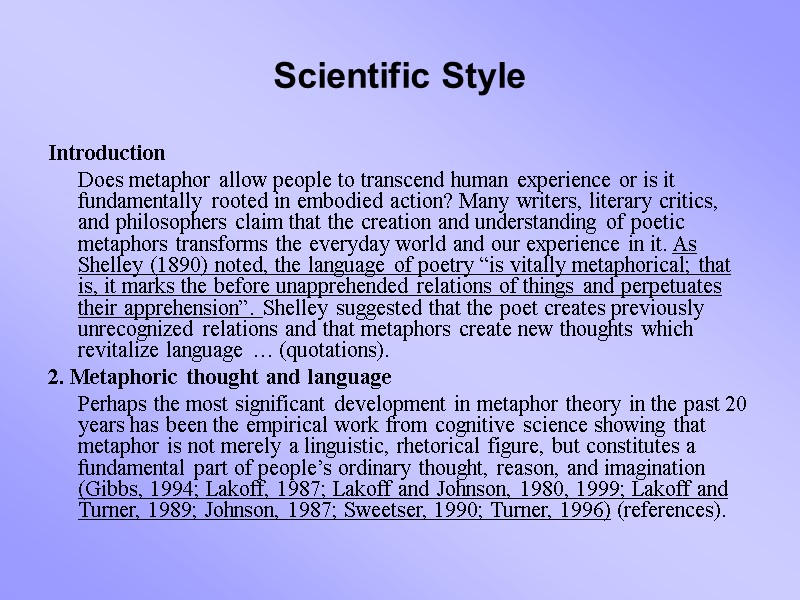

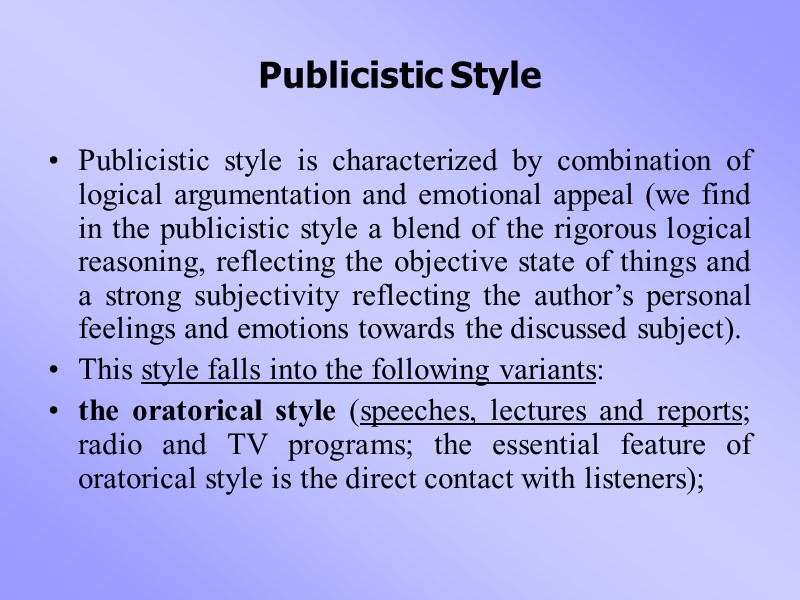

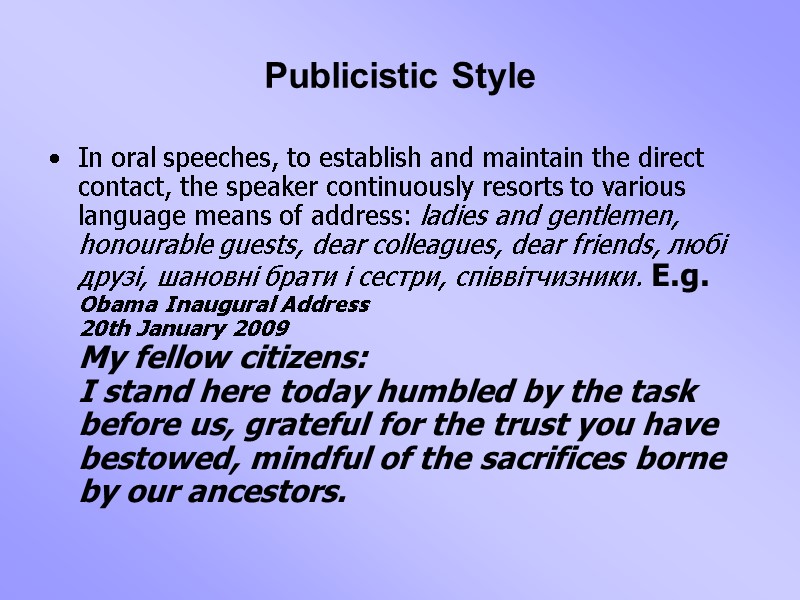
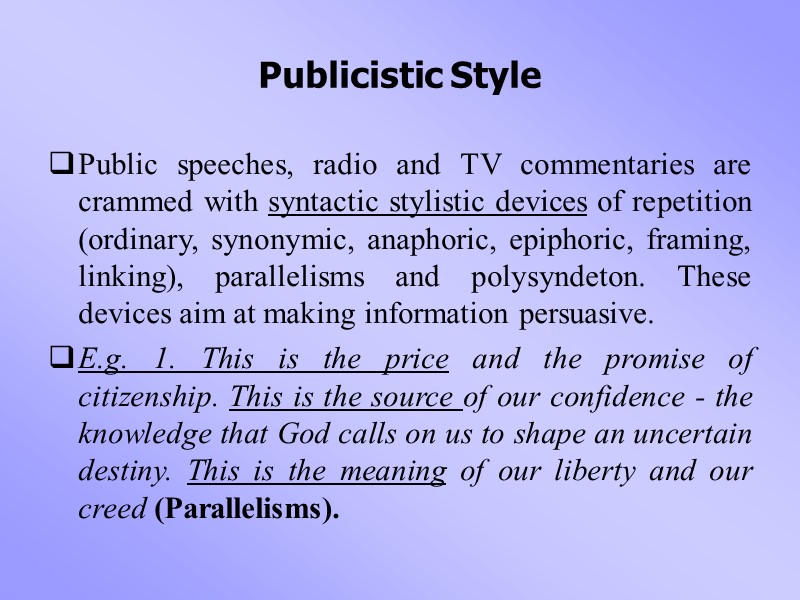
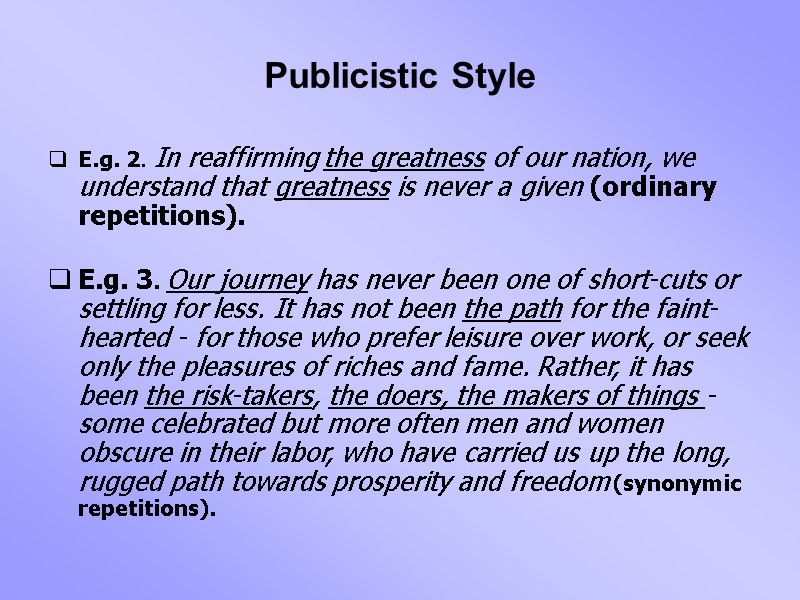
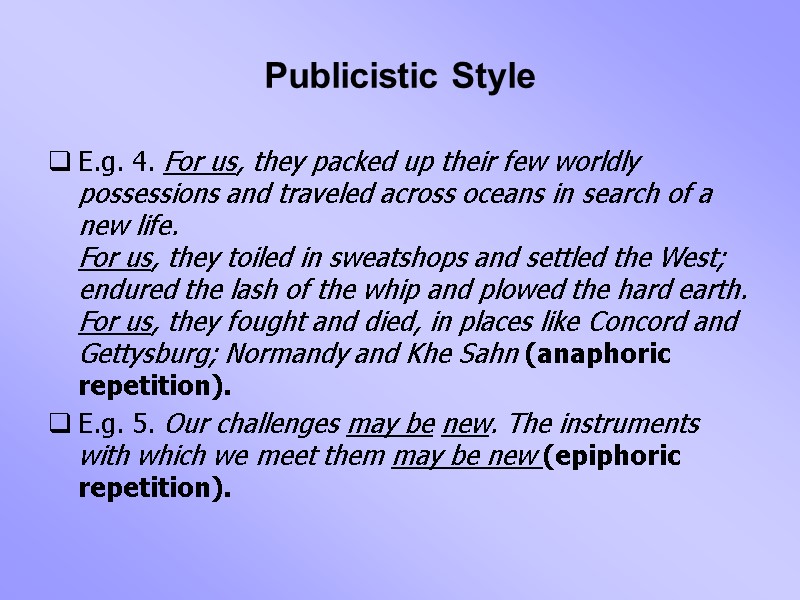
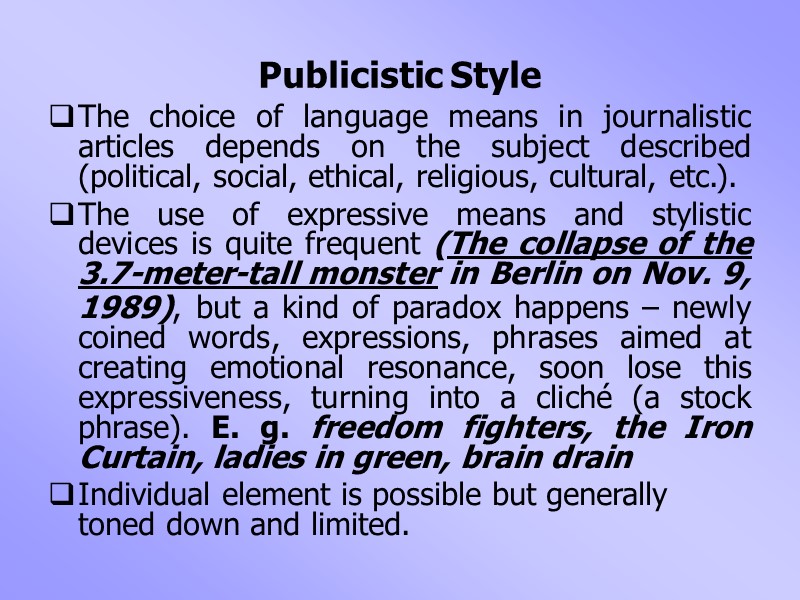
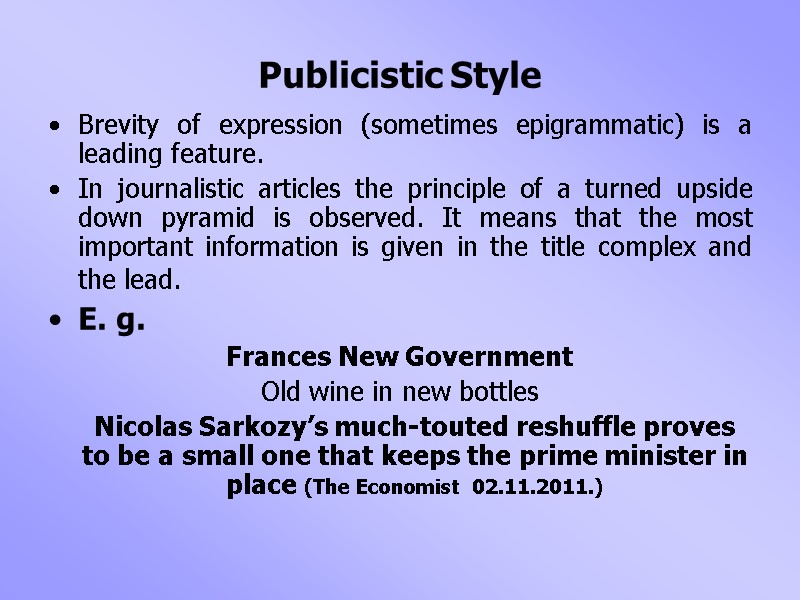
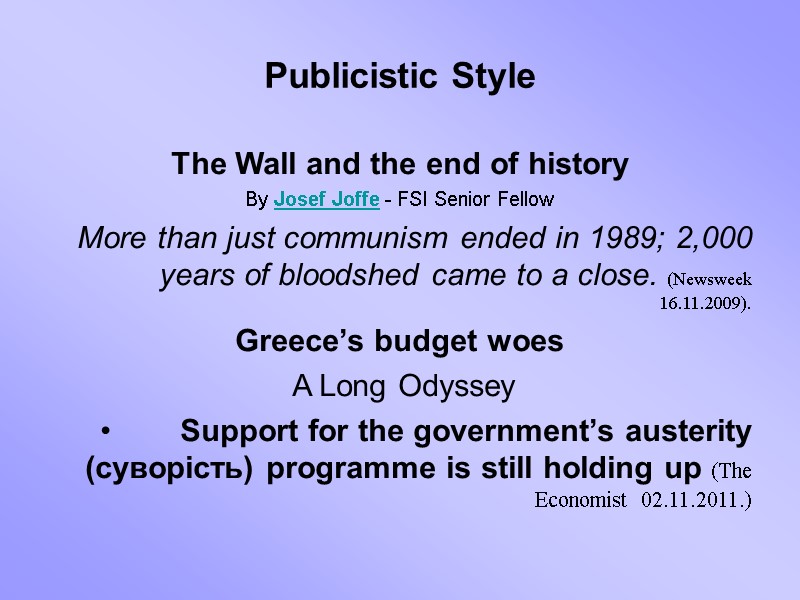
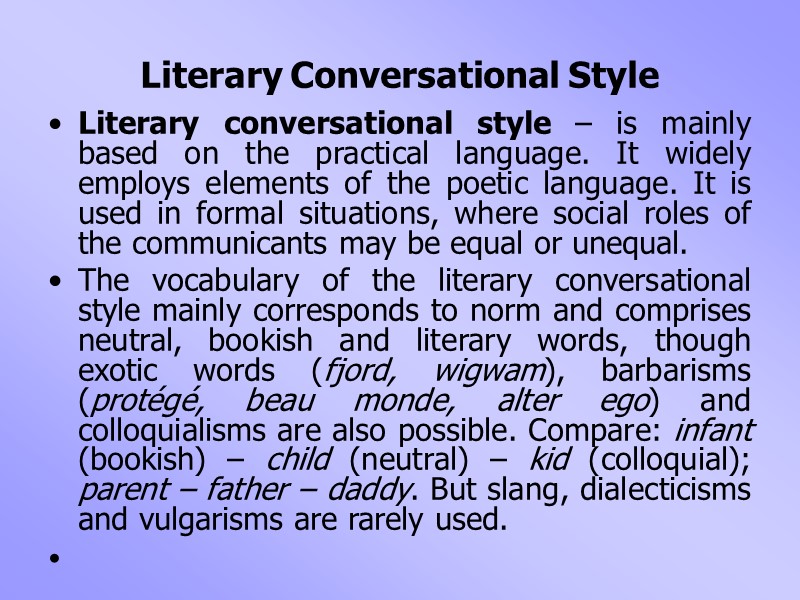
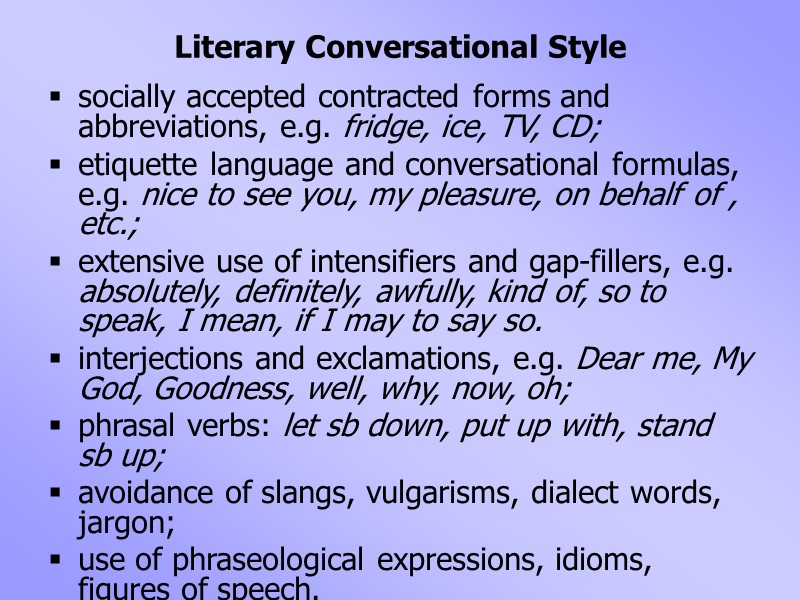
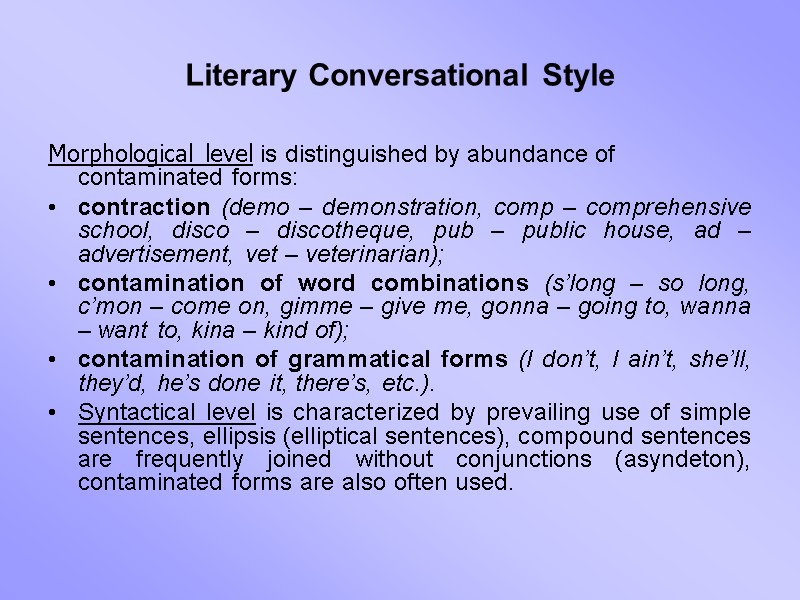
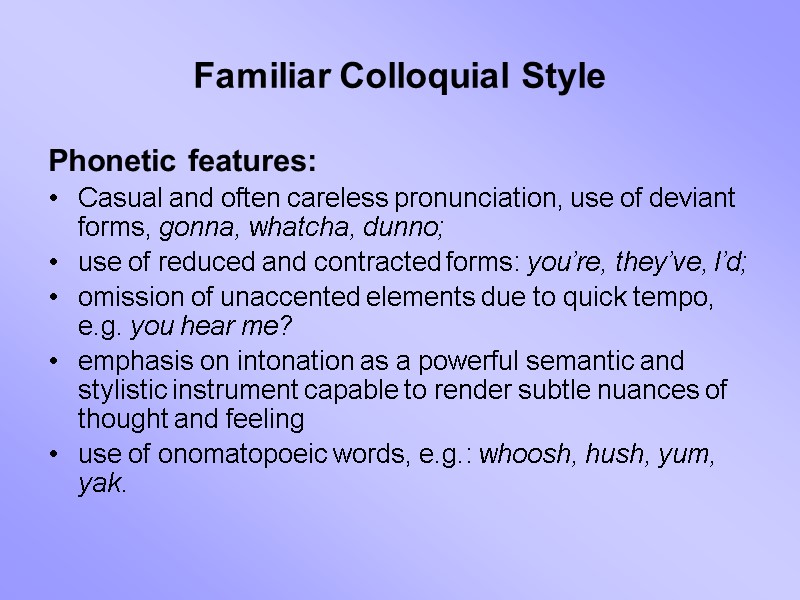
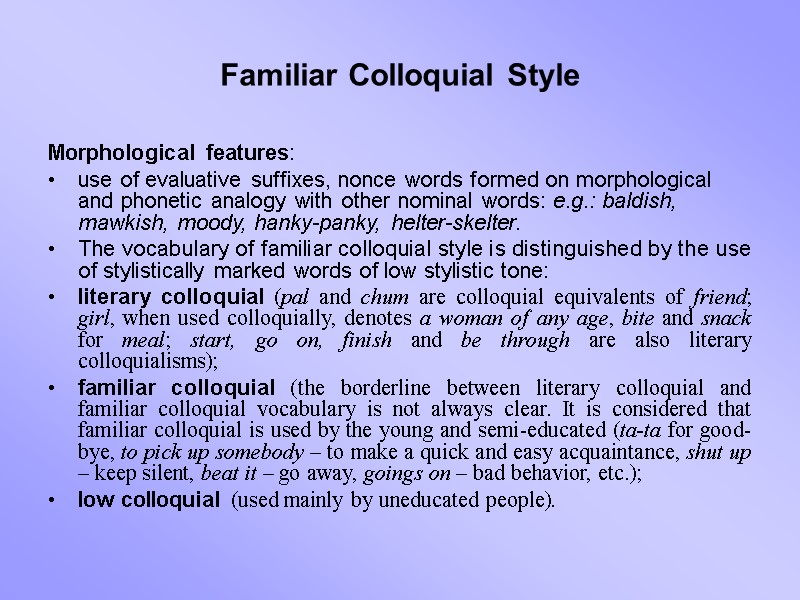
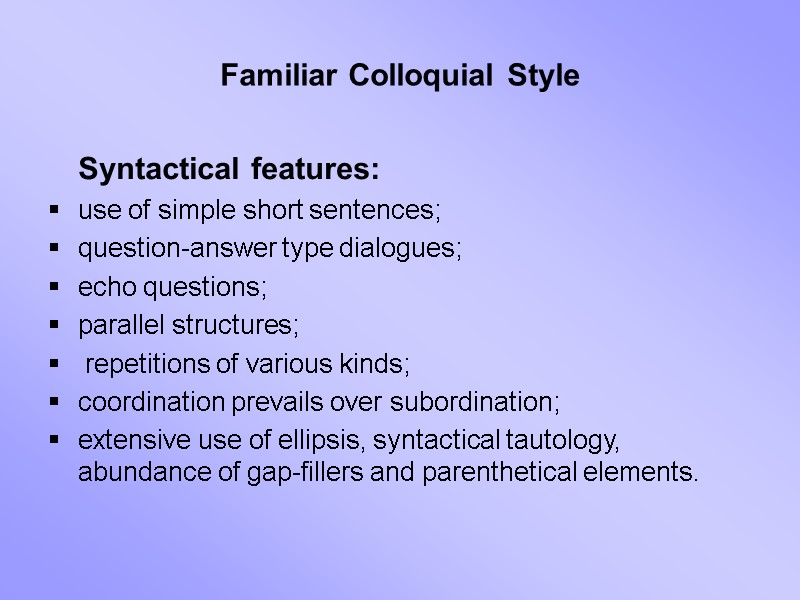
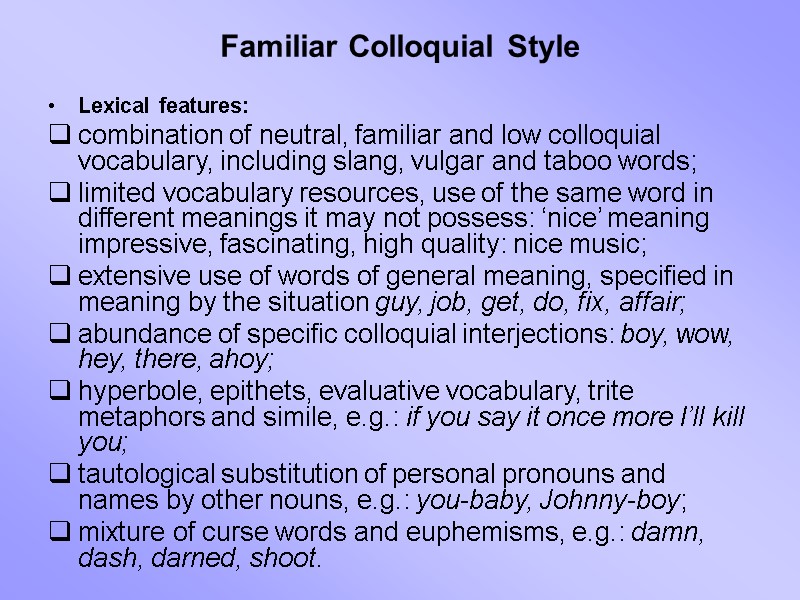
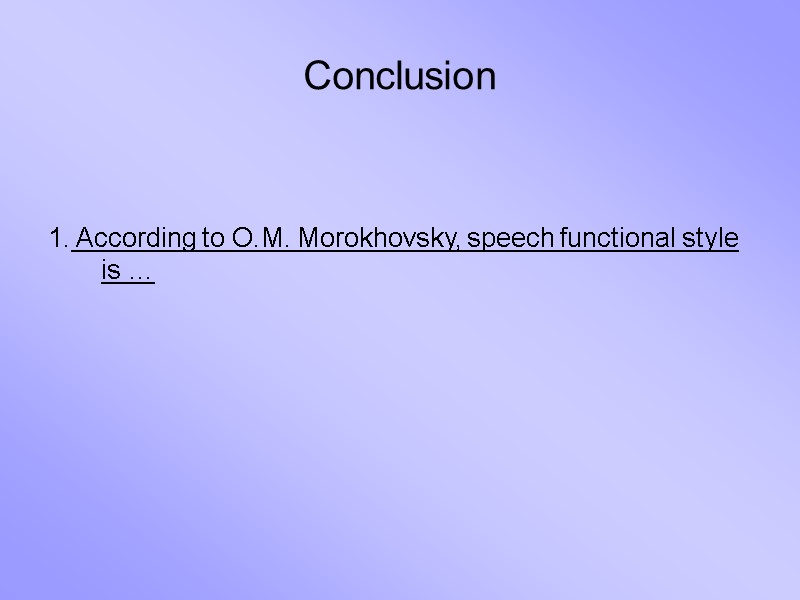
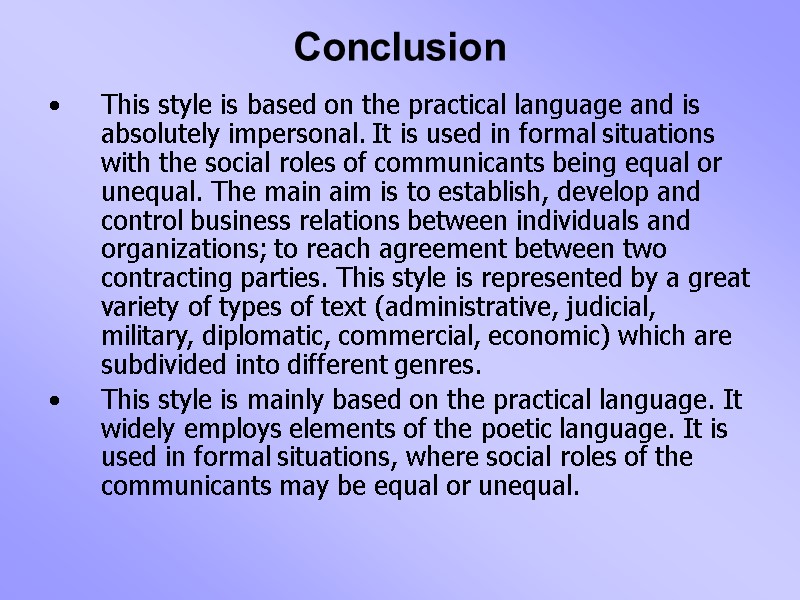
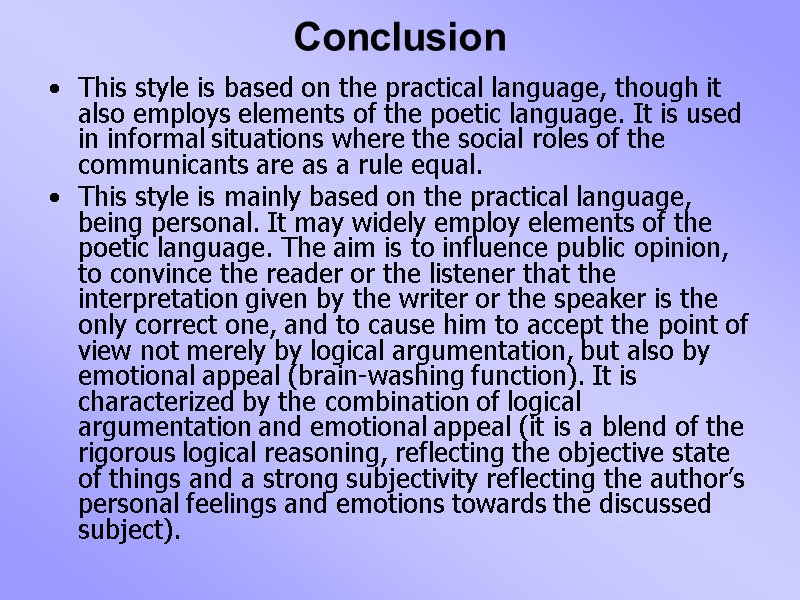
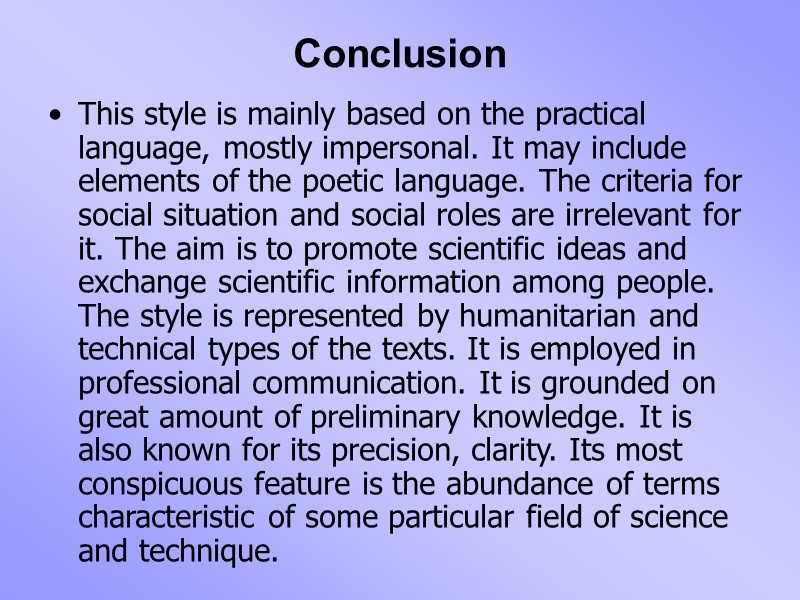
40932-functional_styles.ppt
- Количество слайдов: 60
 FUNCTIONAL STYLES IN MODERN ENGLISH N. P. Izotova, PhD
FUNCTIONAL STYLES IN MODERN ENGLISH N. P. Izotova, PhD
 POINTS FOR DISCUSSION 1. Style as a basic concept of stylistics. 2. Approaches to classification of functional styles. 3. A short survey of functional styles (FSs) in English: a) Official style; b) Scientific style; c) Publicistic style; d) Literary-conversational style; e) Familiar-colloquial style.
POINTS FOR DISCUSSION 1. Style as a basic concept of stylistics. 2. Approaches to classification of functional styles. 3. A short survey of functional styles (FSs) in English: a) Official style; b) Scientific style; c) Publicistic style; d) Literary-conversational style; e) Familiar-colloquial style.
 RECOMMENDED LITERATURE Арнольд И. В. Стилистика современного английского языка. – Л.: Просвещение, 1981. – С. 246-278. Єфімов Л. П., Ясінецька О. А. Стилістика англійської мови і дискурсивний аналіз. Учбово-методичний посібник. – Вінниця: «Нова книга», 2004. – P. 17-23. Мороховский А. Н., Воробьёва О. П., Лихошерст Н. И., Тимошенко З. В. Стилистика английского языка. – К.: Вища шк., 1991. – P. 235-265. Методичні вказівки до семінарських та практичних занять із стилістики англійської мови для студентів IV курсу / Уклад. О.П.Воробйова, Л.Ф.Бойцан, Л.В.Ганецька, О.Ю.Дубенко, І.О.Іноземцева, Л.Р.Чеботарьова, Л.Д.Якимчук. – К.:КДЛУ, 1996 (1997). Galperin I. R. Stylistics. – M.: Нigher School Publ. House. – 1977. – P. 10, 249-318. Kukharenko V.A. Seminars in Stylistics. – M.: Флинта, 2010. – 184 с. Znamenskaya T.A. Stylistics of the English Language. Fundamentals of the course. – M., 2006. – 122-158.
RECOMMENDED LITERATURE Арнольд И. В. Стилистика современного английского языка. – Л.: Просвещение, 1981. – С. 246-278. Єфімов Л. П., Ясінецька О. А. Стилістика англійської мови і дискурсивний аналіз. Учбово-методичний посібник. – Вінниця: «Нова книга», 2004. – P. 17-23. Мороховский А. Н., Воробьёва О. П., Лихошерст Н. И., Тимошенко З. В. Стилистика английского языка. – К.: Вища шк., 1991. – P. 235-265. Методичні вказівки до семінарських та практичних занять із стилістики англійської мови для студентів IV курсу / Уклад. О.П.Воробйова, Л.Ф.Бойцан, Л.В.Ганецька, О.Ю.Дубенко, І.О.Іноземцева, Л.Р.Чеботарьова, Л.Д.Якимчук. – К.:КДЛУ, 1996 (1997). Galperin I. R. Stylistics. – M.: Нigher School Publ. House. – 1977. – P. 10, 249-318. Kukharenko V.A. Seminars in Stylistics. – M.: Флинта, 2010. – 184 с. Znamenskaya T.A. Stylistics of the English Language. Fundamentals of the course. – M., 2006. – 122-158.
 At this lecture you will get to know about: the specificity of ‘style’ as a key concept in stylistics; the system of functional styles in English; features pertinent to each functional style: phonetic, lexical, morphological, syntactical, compositional. how the style can be recognized and described.
At this lecture you will get to know about: the specificity of ‘style’ as a key concept in stylistics; the system of functional styles in English; features pertinent to each functional style: phonetic, lexical, morphological, syntactical, compositional. how the style can be recognized and described.
 What is style? The way something is said, done, expressed, or performed
What is style? The way something is said, done, expressed, or performed
 What is style? The fashion of the moment (a style in dress, vogue, hairdo);
What is style? The fashion of the moment (a style in dress, vogue, hairdo);
 What is style? The combination of distinctive features of literary or artistic expression, execution, or performance characterizing a particular person, group, era.
What is style? The combination of distinctive features of literary or artistic expression, execution, or performance characterizing a particular person, group, era.
 WHAT IS STYLE IN LINGUISTICS? 1. Style as language varieties. A variety of the national language traditionally used in one of the socially identifiable spheres of life that is characterized by a particular set of linguistic features, including vocabulary, grammar and pronunciation. These are chiefly associated with the social and regional varieties, such as educated, colloquial, low colloquial, uneducated, etc. (e.g. Cockney, upper class, educated English)
WHAT IS STYLE IN LINGUISTICS? 1. Style as language varieties. A variety of the national language traditionally used in one of the socially identifiable spheres of life that is characterized by a particular set of linguistic features, including vocabulary, grammar and pronunciation. These are chiefly associated with the social and regional varieties, such as educated, colloquial, low colloquial, uneducated, etc. (e.g. Cockney, upper class, educated English)
 WHAT IS STYLE IN LINGUISTICS? 2. Generally excepted linguistic identity of oral and written units of discourse: a public speech, a lecture, a friendly letter, a newspaper article, etc. 3. Individual manner of expression determined by personal factors, such as educational background, professional experience, sense of humour, etc. (personal style of communication, the style of Ch. Dickens's novels). So, style is a distinctive way of using language for some purpose and to some effect (P. Verdonk)
WHAT IS STYLE IN LINGUISTICS? 2. Generally excepted linguistic identity of oral and written units of discourse: a public speech, a lecture, a friendly letter, a newspaper article, etc. 3. Individual manner of expression determined by personal factors, such as educational background, professional experience, sense of humour, etc. (personal style of communication, the style of Ch. Dickens's novels). So, style is a distinctive way of using language for some purpose and to some effect (P. Verdonk)
 The Problem of Functional Style in English Stylistics regards a language as a certain functional system. English is represented by functional and non-functional variants of language. Non-functional variants of English are conditioned not by pragmatic aims or role relations of speakers but exceptionally by the sphere of the language use: territorial (local dialects – London Cockney, the Southern dialect in the USA); social and professional (social and professional jargons – teenagers’ / students’ jargon, jargon of sportsmen / criminals / drug addicts, etc.
The Problem of Functional Style in English Stylistics regards a language as a certain functional system. English is represented by functional and non-functional variants of language. Non-functional variants of English are conditioned not by pragmatic aims or role relations of speakers but exceptionally by the sphere of the language use: territorial (local dialects – London Cockney, the Southern dialect in the USA); social and professional (social and professional jargons – teenagers’ / students’ jargon, jargon of sportsmen / criminals / drug addicts, etc.
 The Problem of Functional Style in English Functional variants of English or FSs are conditioned by pragmatic aims and social relations of speakers. Aim is a conceivable desirable practical result of human activity. There are two types of hierarchically related aims: the main aim and the supplementary (intermediate) one. The main aim of verbal communication is of pragmatic (nonlingual) character. It presupposes not just conveying information but achieving some pragmatic aim (aim in a concrete speech situation). The supplementary aim is of constructive (lingual) character. It presupposes creating and applying definite means to achieve the main aim.
The Problem of Functional Style in English Functional variants of English or FSs are conditioned by pragmatic aims and social relations of speakers. Aim is a conceivable desirable practical result of human activity. There are two types of hierarchically related aims: the main aim and the supplementary (intermediate) one. The main aim of verbal communication is of pragmatic (nonlingual) character. It presupposes not just conveying information but achieving some pragmatic aim (aim in a concrete speech situation). The supplementary aim is of constructive (lingual) character. It presupposes creating and applying definite means to achieve the main aim.
 The Problem of Functional Style in English Function is defined either as a relation of one element to another or as a role (‘призначення’) of an element in a system as well a role of the whole system in wider environment. As in modern linguistics 3 areas of language are distinguished, namely, language system (langue), speech activity (performance) and speech material/ speech (parole), the notion of function has certain peculiarities applied to each of these areas. Understanding of style is different too as applied to language, speech activity and speech. Accordingly, three types of stylistics may be distinguished: stylistics of language, stylistics of activity, stylistics of speech.
The Problem of Functional Style in English Function is defined either as a relation of one element to another or as a role (‘призначення’) of an element in a system as well a role of the whole system in wider environment. As in modern linguistics 3 areas of language are distinguished, namely, language system (langue), speech activity (performance) and speech material/ speech (parole), the notion of function has certain peculiarities applied to each of these areas. Understanding of style is different too as applied to language, speech activity and speech. Accordingly, three types of stylistics may be distinguished: stylistics of language, stylistics of activity, stylistics of speech.
 The Problem of Functional Style in English Stylistics of language Functional types of language Practical Poetic oral written oral written Functional types of language constitute the basis for the stylistic differentiation of speech activity and speech which serve the ground for defining functional style.
The Problem of Functional Style in English Stylistics of language Functional types of language Practical Poetic oral written oral written Functional types of language constitute the basis for the stylistic differentiation of speech activity and speech which serve the ground for defining functional style.
 The Concept of Functional Style There are two main approaches to its definition both originating from Accad. V. V. Vinogradov’s conception. According to the first approach, style is defined on the criterion of function as socially accepted, functionally conditioned and internally organized system of the ways of usage, choice and combination of communicative verbal means which correlate with other similar systems serving other aims and fulfilling other functions in speech practice of a nation. According to the second approach style is defined with regard to its components. It is viewed as a system of language means united by the similarity of their function or by the sphere of usage.
The Concept of Functional Style There are two main approaches to its definition both originating from Accad. V. V. Vinogradov’s conception. According to the first approach, style is defined on the criterion of function as socially accepted, functionally conditioned and internally organized system of the ways of usage, choice and combination of communicative verbal means which correlate with other similar systems serving other aims and fulfilling other functions in speech practice of a nation. According to the second approach style is defined with regard to its components. It is viewed as a system of language means united by the similarity of their function or by the sphere of usage.
 What is functional style? Prof. Arnold I. V. – FSs are subsystems of language which possess their specific peculiarities in vocabulary, phraseology, syntactical constructions and sometimes phonetics. Prof. Galperin I. R. – FS of language is a system of interrelated language means which serve a definite aim in communication. A FS is thus to be regarded as the product of a certain concrete task set by the sender of the message. Prof. Screbnev Y. M. considers that FSs are descriptive features of subsystems of language which serve different spheres of communication. FS is construed with the help of specific constituents of these or those sublanguages.
What is functional style? Prof. Arnold I. V. – FSs are subsystems of language which possess their specific peculiarities in vocabulary, phraseology, syntactical constructions and sometimes phonetics. Prof. Galperin I. R. – FS of language is a system of interrelated language means which serve a definite aim in communication. A FS is thus to be regarded as the product of a certain concrete task set by the sender of the message. Prof. Screbnev Y. M. considers that FSs are descriptive features of subsystems of language which serve different spheres of communication. FS is construed with the help of specific constituents of these or those sublanguages.
 Quite different interpretation of FS was suggested by Prof. Morokhovsky O. M. and his followers who regarded FS as the property of stylistics of speech activity. The speech functional style is defined as a socially accepted stereotype of speech behaviour conditioned by social situation of communication (formal or informal), social roles of communicants (equal or unequal; a parent and a child, a teacher and a student, a scientist, a journalist and the audience) and their pragmatic aims.
Quite different interpretation of FS was suggested by Prof. Morokhovsky O. M. and his followers who regarded FS as the property of stylistics of speech activity. The speech functional style is defined as a socially accepted stereotype of speech behaviour conditioned by social situation of communication (formal or informal), social roles of communicants (equal or unequal; a parent and a child, a teacher and a student, a scientist, a journalist and the audience) and their pragmatic aims.
 Approaches to Classification of Functional Styles deductive (from the general to the specific) inductive (from the specific to the general). The deductive approach is based on the classification criteria which are regarded as given but not directly extracted from the speech material. According to this approach functional styles are classified on the basis of the language function, the sphere of usage and the set of differential signs.
Approaches to Classification of Functional Styles deductive (from the general to the specific) inductive (from the specific to the general). The deductive approach is based on the classification criteria which are regarded as given but not directly extracted from the speech material. According to this approach functional styles are classified on the basis of the language function, the sphere of usage and the set of differential signs.
 The functional style classification on the basis of the language function Sticking to this classification, the linguists recognize not only two basic language functions (communicative and cognitive) but also additional / specific ones. A. M. Peshkovskiy’s classification belles-lettres style the purpose of which is to influence the readers’ imagination to evoke aesthetic feelings; oratorical style and the style of advertisement the purpose of which is to influence the recipients’ wills; the style of lecture speech aimed at popularization of some ideas and making them easy for understanding.
The functional style classification on the basis of the language function Sticking to this classification, the linguists recognize not only two basic language functions (communicative and cognitive) but also additional / specific ones. A. M. Peshkovskiy’s classification belles-lettres style the purpose of which is to influence the readers’ imagination to evoke aesthetic feelings; oratorical style and the style of advertisement the purpose of which is to influence the recipients’ wills; the style of lecture speech aimed at popularization of some ideas and making them easy for understanding.
 The functional style classification on the basis of the language function Ac. Vinogradov V. V. singled out 3 language functions – communication, informing and influence. Thus, the function of communication is realized in colloquial style, of informing – in official-documentary style and of influence – in belles-lettres and publicistic styles.
The functional style classification on the basis of the language function Ac. Vinogradov V. V. singled out 3 language functions – communication, informing and influence. Thus, the function of communication is realized in colloquial style, of informing – in official-documentary style and of influence – in belles-lettres and publicistic styles.
 The functional style classification on the basis of the sphere of language use There was an attempt to classify functional styles in accordance with all possible spheres of their usage – social and speech situations of human communication. As the number of such situations is extremely large, they were generalized and typified. So firstly, two historically formed spheres of communication were singled out: oral and written and correspondingly colloquial and bookish speeches were distinguished. Then the styles of oral and written communication were classified further (written – into scientific and belles-lettres styles; colloquial – into literary-conversational and familiar-colloquial).
The functional style classification on the basis of the sphere of language use There was an attempt to classify functional styles in accordance with all possible spheres of their usage – social and speech situations of human communication. As the number of such situations is extremely large, they were generalized and typified. So firstly, two historically formed spheres of communication were singled out: oral and written and correspondingly colloquial and bookish speeches were distinguished. Then the styles of oral and written communication were classified further (written – into scientific and belles-lettres styles; colloquial – into literary-conversational and familiar-colloquial).
 The functional style classification on the basis of three differential features emotiveness / non-emotiveness spontaneity / non-spontaneity correspondence to norm / not correspondence to norm and combinations of the enumerated features 8 theoretically possible classes were singled out that included all possible FSs.
The functional style classification on the basis of three differential features emotiveness / non-emotiveness spontaneity / non-spontaneity correspondence to norm / not correspondence to norm and combinations of the enumerated features 8 theoretically possible classes were singled out that included all possible FSs.
 The Inductive Approach The criteria for classification according to the inductive approach are not given but they are extracted from a certain speech material. The procedure is the following: the researcher having a certain number of utterances and texts classifies them into groups on the basis of lexical, syntactical and other parameters of resemblance. Thus, each group of texts will represent a certain functional style.
The Inductive Approach The criteria for classification according to the inductive approach are not given but they are extracted from a certain speech material. The procedure is the following: the researcher having a certain number of utterances and texts classifies them into groups on the basis of lexical, syntactical and other parameters of resemblance. Thus, each group of texts will represent a certain functional style.
 Approaches to Classification of Functional Styles Irrespective of the approaches adopted, scholars usually distinguish the following styles: conversational, official or documentary, scientific, publicistic and oratorical, newspaper style, and belles-lettres style. The status of belles-lettres style, newspaper style and conversational style is still controversial. Belles-lettres style – following the differentiation of the primary and secondary semiotic systems it is possible to assume that the poetic language and the language of fiction does not constitute a functional style comparable with other functional styles but it constitutes a specific type of language.
Approaches to Classification of Functional Styles Irrespective of the approaches adopted, scholars usually distinguish the following styles: conversational, official or documentary, scientific, publicistic and oratorical, newspaper style, and belles-lettres style. The status of belles-lettres style, newspaper style and conversational style is still controversial. Belles-lettres style – following the differentiation of the primary and secondary semiotic systems it is possible to assume that the poetic language and the language of fiction does not constitute a functional style comparable with other functional styles but it constitutes a specific type of language.
 Approaches to Classification of Functional Styles The status of newspaper style is also doubtful. Some scholars consider that the existence of this style is conditioned by the specific aims of mass media and by the peculiarities of the linguistic means used in newspaper. But these peculiarities manifest themselves only in limited newspaper units – headlines, brief news (briefings) and editorials. Thus, it is more reasonable to speak about the newspaper language rather than about the newspaper style. Prof. Galperin I. R. excluded conversational style from the inventory of FSs, because his classification was based on entirely the written type of language. Though conversational style in Modern English is used even more widely than written language and is not homogeneous at all. Generally, the following functional styles can be distinguished: official style, scientific style, publicistic style, literary conversational style, colloquial style.
Approaches to Classification of Functional Styles The status of newspaper style is also doubtful. Some scholars consider that the existence of this style is conditioned by the specific aims of mass media and by the peculiarities of the linguistic means used in newspaper. But these peculiarities manifest themselves only in limited newspaper units – headlines, brief news (briefings) and editorials. Thus, it is more reasonable to speak about the newspaper language rather than about the newspaper style. Prof. Galperin I. R. excluded conversational style from the inventory of FSs, because his classification was based on entirely the written type of language. Though conversational style in Modern English is used even more widely than written language and is not homogeneous at all. Generally, the following functional styles can be distinguished: official style, scientific style, publicistic style, literary conversational style, colloquial style.
 Approaches to Classification of Functional Styles Functional styles are represented by different types of utterances and texts. These are different classes of texts within a FS which differ in their semantic and topical characteristics. Thus the texts of publicistic style may be subdivided into texts on politics, economics, moral, art, religion, health, etc. Each type of the texts is realized in a certain genre of the text. These are types of the text subdivided according to their compositional and stylistic peculiarities. The military texts for instance are divided into orders, reports, instructions and regulations. Each of the enumerated styles is exercised in two forms — written and oral: an article and a lecture are examples of the two forms of the scientific style, an essay and a public speech — of the publicistic style, etc.
Approaches to Classification of Functional Styles Functional styles are represented by different types of utterances and texts. These are different classes of texts within a FS which differ in their semantic and topical characteristics. Thus the texts of publicistic style may be subdivided into texts on politics, economics, moral, art, religion, health, etc. Each type of the texts is realized in a certain genre of the text. These are types of the text subdivided according to their compositional and stylistic peculiarities. The military texts for instance are divided into orders, reports, instructions and regulations. Each of the enumerated styles is exercised in two forms — written and oral: an article and a lecture are examples of the two forms of the scientific style, an essay and a public speech — of the publicistic style, etc.
 Official Style Official style is devoid of expressiveness, emotiveness and subjective modality (except business correspondence where conventional phrases of greeting or close are to be found such as Dear Sir, For the attention of Mr. E. Wilson, Sincerely T. W. Thomas, Chairman, Yours faithfully). This style is the most conservative one. It preserves cast-iron forms of structuring and uses syntactical constructions and words long known as archaic and not observed anywhere else.
Official Style Official style is devoid of expressiveness, emotiveness and subjective modality (except business correspondence where conventional phrases of greeting or close are to be found such as Dear Sir, For the attention of Mr. E. Wilson, Sincerely T. W. Thomas, Chairman, Yours faithfully). This style is the most conservative one. It preserves cast-iron forms of structuring and uses syntactical constructions and words long known as archaic and not observed anywhere else.
 Official Style Its special language forms are rather peculiar: The graphical level of this style is distinguished by specific rules of making inscriptions, using capital letters and abbreviations. E. g. A/C, acc. (account current) – поточний рахунок, adsd (addressed) – адресовано, B/E, b.e. (bill of exchange) – переводний вексель, трата, Co. (company), CV (curriculum vitae) – коротка біографія, LOC (letter of commitment) – гарантійний лист, IOY (I owe you) – боргова розписка, urgt (urgent) – терміновий , etc.
Official Style Its special language forms are rather peculiar: The graphical level of this style is distinguished by specific rules of making inscriptions, using capital letters and abbreviations. E. g. A/C, acc. (account current) – поточний рахунок, adsd (addressed) – адресовано, B/E, b.e. (bill of exchange) – переводний вексель, трата, Co. (company), CV (curriculum vitae) – коротка біографія, LOC (letter of commitment) – гарантійний лист, IOY (I owe you) – боргова розписка, urgt (urgent) – терміновий , etc.
 Official Style The lexical level is characterized by domination of bookish, borrowed, archaic and obsolescent words, terms and clichés, such as “aviso” (авізо), “interest-free” (безвідсотковий), “fidejussor” (поручитель), “flagrante delicto” (на місті злочину), “status quo”; In reply to your letter, We are pleased to enclose our order…, We are sorry to inform that our client became insolvent.
Official Style The lexical level is characterized by domination of bookish, borrowed, archaic and obsolescent words, terms and clichés, such as “aviso” (авізо), “interest-free” (безвідсотковий), “fidejussor” (поручитель), “flagrante delicto” (на місті злочину), “status quo”; In reply to your letter, We are pleased to enclose our order…, We are sorry to inform that our client became insolvent.
 Official Style The morphological features of the style: the usage of Subjunctive I (It is urgent you confirm the arrival of the delegation ) and the Suppositional Mood (It is requested that you should confirm your order), wide use of non-finite forms of the verb, impersonal and indefinite pronouns. The syntactical level is distinguished by long and super-long sentences of all structural types, always two-member and no elliptical, complicated by complexes of secondary predication, detachments (відокремлені конструкції), parenthetic insertions and passive constructions.
Official Style The morphological features of the style: the usage of Subjunctive I (It is urgent you confirm the arrival of the delegation ) and the Suppositional Mood (It is requested that you should confirm your order), wide use of non-finite forms of the verb, impersonal and indefinite pronouns. The syntactical level is distinguished by long and super-long sentences of all structural types, always two-member and no elliptical, complicated by complexes of secondary predication, detachments (відокремлені конструкції), parenthetic insertions and passive constructions.
 Official Style Professor W.H. Leeman 79 Rigby Drive London Dorset, Merseyside 10th March 1998 Dear Sir! Contributed papers accepted for the Conference will be presented in oral sessions or in poster sessions, each type of presentation being considered of equal importance for the success of the conference. The choice between the one or the other way of presentation will be made by the Programme Committee. The first is a ten-minute talk in a conventional session, followed by a poster presentation in a poster area. In the poster period (about two hours) authors will post visual material about their work on a designated board and will be prepared to present details and answer questions relating to their paper. The second mode of presentation is the conventional format of twenty-minute talks without poster periods. This will be used for some sessions, particularly those for which public discussion is especially important or for which there is a large well-defined audience. Sincerely T. W. Thomas, Chairman.
Official Style Professor W.H. Leeman 79 Rigby Drive London Dorset, Merseyside 10th March 1998 Dear Sir! Contributed papers accepted for the Conference will be presented in oral sessions or in poster sessions, each type of presentation being considered of equal importance for the success of the conference. The choice between the one or the other way of presentation will be made by the Programme Committee. The first is a ten-minute talk in a conventional session, followed by a poster presentation in a poster area. In the poster period (about two hours) authors will post visual material about their work on a designated board and will be prepared to present details and answer questions relating to their paper. The second mode of presentation is the conventional format of twenty-minute talks without poster periods. This will be used for some sessions, particularly those for which public discussion is especially important or for which there is a large well-defined audience. Sincerely T. W. Thomas, Chairman.
 Scientific Style Scientific style – is mainly based on the practical language, mostly impersonal. It may include elements of the poetic language. The criteria for social situation and social roles are irrelevant for it. The aim is to promote scientific ideas and exchange scientific information among people. The style is represented by humanitarian and technical types of the texts which are subdivided into the following genres: a treatise (монографія), a scientific article, a report, a dissertation, an abstract, an author’s abstract of dissertation (автореферат), an annotation, a review (рецензія), theses, a textbook, etc.
Scientific Style Scientific style – is mainly based on the practical language, mostly impersonal. It may include elements of the poetic language. The criteria for social situation and social roles are irrelevant for it. The aim is to promote scientific ideas and exchange scientific information among people. The style is represented by humanitarian and technical types of the texts which are subdivided into the following genres: a treatise (монографія), a scientific article, a report, a dissertation, an abstract, an author’s abstract of dissertation (автореферат), an annotation, a review (рецензія), theses, a textbook, etc.
 Scientific Style Scientific style is employed in professional communication. It is grounded on great amount of preliminary knowledge. Scientific style is also known for its precision, clarity. Its most conspicuous feature is the abundance of terms characteristic of some particular field of science and technique. The graphical level of scientific style is characterized by a number- or letter-indexed paragraphing, a developed system of headlines, titles and subtitles, footnotes, quotations, references, pictures, tables, schemes and formulae.
Scientific Style Scientific style is employed in professional communication. It is grounded on great amount of preliminary knowledge. Scientific style is also known for its precision, clarity. Its most conspicuous feature is the abundance of terms characteristic of some particular field of science and technique. The graphical level of scientific style is characterized by a number- or letter-indexed paragraphing, a developed system of headlines, titles and subtitles, footnotes, quotations, references, pictures, tables, schemes and formulae.
 Scientific Style Vocabulary is constituted by special terms specific to each given branch of science. Most of such terms are borrowed from English into other languages with preservation of their original form and sounding (monitor, modem, interface, scanner, conceptual metaphor, concept, prototype, media discourse). The rest are translated by the way of loan-translation (image-schema – образ-схема, vantage theory – теорія перспектив, software – комп’ютерні програми, hardware – компоненти ЕВМ). The scientific vocabulary also abounds in set-phrases and clichés which introduce specific flavour of bookishness and scientific character of the text (We proceed from the assumption that..., One can observe that..., As a matter of fact..., As is generally accepted..., etc.). Words are used in their direct denotative meaning (no contextual meanings).
Scientific Style Vocabulary is constituted by special terms specific to each given branch of science. Most of such terms are borrowed from English into other languages with preservation of their original form and sounding (monitor, modem, interface, scanner, conceptual metaphor, concept, prototype, media discourse). The rest are translated by the way of loan-translation (image-schema – образ-схема, vantage theory – теорія перспектив, software – комп’ютерні програми, hardware – компоненти ЕВМ). The scientific vocabulary also abounds in set-phrases and clichés which introduce specific flavour of bookishness and scientific character of the text (We proceed from the assumption that..., One can observe that..., As a matter of fact..., As is generally accepted..., etc.). Words are used in their direct denotative meaning (no contextual meanings).
 Scientific Style One of the most noticeable morphological features of this style is the use of personal pronoun “We” in the meaning “I”. The scientific “We” is called “the plural modesty”. E. g. In tagmemics we make a crucial theoretical difference between the grammatical hierarchy and the referential one.
Scientific Style One of the most noticeable morphological features of this style is the use of personal pronoun “We” in the meaning “I”. The scientific “We” is called “the plural modesty”. E. g. In tagmemics we make a crucial theoretical difference between the grammatical hierarchy and the referential one.
 Scientific Style Syntactical level is distinguished by a developed system of connectives that provides logical cohesion which is responsible for the repeated use of such clichés as: “Proceeding from...”; “As it was said above...”; “In connection with…” , “In conclusion … “ and other lexico-syntactical forms emphasizing the logical connection and interdependence of consecutive parts of the discourse.
Scientific Style Syntactical level is distinguished by a developed system of connectives that provides logical cohesion which is responsible for the repeated use of such clichés as: “Proceeding from...”; “As it was said above...”; “In connection with…” , “In conclusion … “ and other lexico-syntactical forms emphasizing the logical connection and interdependence of consecutive parts of the discourse.
 Scientific Style Also Scientific style is characterized by frequent use of passive constructions, infinitive constructions. E. g. In a normal instance of reporting a single event in time, the two are potentially isomorphic with coterminous borders. But when simultaneous, must be sequenced in the report. In some cases, a chronological or logical sequence can in English be partially or completely changed in presentational order (e.g. told backwards); Describing a static situation presents problems parallel to those of presenting an event involving change or movement. Impersonal passive constructions are frequently used with the verbs suppose, assume, point out (It is assumed…, It is supposed that…).
Scientific Style Also Scientific style is characterized by frequent use of passive constructions, infinitive constructions. E. g. In a normal instance of reporting a single event in time, the two are potentially isomorphic with coterminous borders. But when simultaneous, must be sequenced in the report. In some cases, a chronological or logical sequence can in English be partially or completely changed in presentational order (e.g. told backwards); Describing a static situation presents problems parallel to those of presenting an event involving change or movement. Impersonal passive constructions are frequently used with the verbs suppose, assume, point out (It is assumed…, It is supposed that…).
 Scientific Style Abstract ТОТИВНІ ДІЄСЛОВА У СФЕРІ ВЖИВАННЯ ЗАГАЛЬНОРЕЗУЛЬТАТИВНОГО СПОСОБУ ДІЄСЛІВНОЇ ДІЇ Тетяна АНДРЕЄВА (Кіровоград, Україна) The apportionment of resulting-totive predicates is investigated in this paper. The description of semantic, grammatical and functional traits of these syntaxemes is given. The means of their syntaxeme expression and their subordination to other predicative units are analyzed. Key words: resulting-totive predicates, semantic, grammatical and functional traits, syntaxeme, predicative unit.
Scientific Style Abstract ТОТИВНІ ДІЄСЛОВА У СФЕРІ ВЖИВАННЯ ЗАГАЛЬНОРЕЗУЛЬТАТИВНОГО СПОСОБУ ДІЄСЛІВНОЇ ДІЇ Тетяна АНДРЕЄВА (Кіровоград, Україна) The apportionment of resulting-totive predicates is investigated in this paper. The description of semantic, grammatical and functional traits of these syntaxemes is given. The means of their syntaxeme expression and their subordination to other predicative units are analyzed. Key words: resulting-totive predicates, semantic, grammatical and functional traits, syntaxeme, predicative unit.
 Scientific Style Article Journal of Pragmatics 36 (2004) 1189–1210 Metaphor is grounded in embodied experience Raymond W. Gibbs Jr.a,*, Paula Lenz Costa Limab, Edson Francozoc aDepartment of Psychology, University of California, Santa Cruz, CA 95064, USA Universidade Estadual do Ceara, Avenida Paranjana, Fortaleza, Ceara, Brazil cUniversidade Estadual de Campinas, Campinas, Sa˜o Paulo, Brazil Received 5 June 2000; received in revised form 12 September 2003; accepted 8 October 2003 Abstract What role do people’s embodied experiences have in their use and understanding of metaphor? Contrary to the traditional belief that metaphor transcends human experience and best reflects metaphysical truths, there is substantial evidence from cognitive science that demonstrates how metaphor is fundamentally grounded in embodiment. We review this empirical evidence and discuss the methodological strategies employed by linguists and psychologists seeking connections between embodiment and metaphor. A case study of how people think and speak of desire in terms of hunger, specifically shows how systematic patterns of bodily experience serve as the source domains for many cross-linguistic metaphorical mappings. These data provide strong evidence in favor of the idea that metaphorical thought and language arises from, and is grounded in, embodiment.
Scientific Style Article Journal of Pragmatics 36 (2004) 1189–1210 Metaphor is grounded in embodied experience Raymond W. Gibbs Jr.a,*, Paula Lenz Costa Limab, Edson Francozoc aDepartment of Psychology, University of California, Santa Cruz, CA 95064, USA Universidade Estadual do Ceara, Avenida Paranjana, Fortaleza, Ceara, Brazil cUniversidade Estadual de Campinas, Campinas, Sa˜o Paulo, Brazil Received 5 June 2000; received in revised form 12 September 2003; accepted 8 October 2003 Abstract What role do people’s embodied experiences have in their use and understanding of metaphor? Contrary to the traditional belief that metaphor transcends human experience and best reflects metaphysical truths, there is substantial evidence from cognitive science that demonstrates how metaphor is fundamentally grounded in embodiment. We review this empirical evidence and discuss the methodological strategies employed by linguists and psychologists seeking connections between embodiment and metaphor. A case study of how people think and speak of desire in terms of hunger, specifically shows how systematic patterns of bodily experience serve as the source domains for many cross-linguistic metaphorical mappings. These data provide strong evidence in favor of the idea that metaphorical thought and language arises from, and is grounded in, embodiment.
 Scientific Style Introduction Does metaphor allow people to transcend human experience or is it fundamentally rooted in embodied action? Many writers, literary critics, and philosophers claim that the creation and understanding of poetic metaphors transforms the everyday world and our experience in it. As Shelley (1890) noted, the language of poetry “is vitally metaphorical; that is, it marks the before unapprehended relations of things and perpetuates their apprehension”. Shelley suggested that the poet creates previously unrecognized relations and that metaphors create new thoughts which revitalize language … (quotations). 2. Metaphoric thought and language Perhaps the most significant development in metaphor theory in the past 20 years has been the empirical work from cognitive science showing that metaphor is not merely a linguistic, rhetorical figure, but constitutes a fundamental part of people’s ordinary thought, reason, and imagination (Gibbs, 1994; Lakoff, 1987; Lakoff and Johnson, 1980, 1999; Lakoff and Turner, 1989; Johnson, 1987; Sweetser, 1990; Turner, 1996) (references).
Scientific Style Introduction Does metaphor allow people to transcend human experience or is it fundamentally rooted in embodied action? Many writers, literary critics, and philosophers claim that the creation and understanding of poetic metaphors transforms the everyday world and our experience in it. As Shelley (1890) noted, the language of poetry “is vitally metaphorical; that is, it marks the before unapprehended relations of things and perpetuates their apprehension”. Shelley suggested that the poet creates previously unrecognized relations and that metaphors create new thoughts which revitalize language … (quotations). 2. Metaphoric thought and language Perhaps the most significant development in metaphor theory in the past 20 years has been the empirical work from cognitive science showing that metaphor is not merely a linguistic, rhetorical figure, but constitutes a fundamental part of people’s ordinary thought, reason, and imagination (Gibbs, 1994; Lakoff, 1987; Lakoff and Johnson, 1980, 1999; Lakoff and Turner, 1989; Johnson, 1987; Sweetser, 1990; Turner, 1996) (references).
 Publicistic Style Publicistic style – is mainly based on the practical language, being personal. It may widely employ elements of the poetic language. The aim is to influence public opinion, to convince the reader or the listener that the interpretation given by the writer or the speaker is the only correct one, and to cause him to accept the point of view … not merely by logical argumentation, but by emotional appeal as well (brain-washing function).
Publicistic Style Publicistic style – is mainly based on the practical language, being personal. It may widely employ elements of the poetic language. The aim is to influence public opinion, to convince the reader or the listener that the interpretation given by the writer or the speaker is the only correct one, and to cause him to accept the point of view … not merely by logical argumentation, but by emotional appeal as well (brain-washing function).
 Publicistic Style Publicistic style is characterized by combination of logical argumentation and emotional appeal (we find in the publicistic style a blend of the rigorous logical reasoning, reflecting the objective state of things and a strong subjectivity reflecting the author’s personal feelings and emotions towards the discussed subject). This style falls into the following variants: the oratorical style (speeches, lectures and reports; radio and TV programs; the essential feature of oratorical style is the direct contact with listeners);
Publicistic Style Publicistic style is characterized by combination of logical argumentation and emotional appeal (we find in the publicistic style a blend of the rigorous logical reasoning, reflecting the objective state of things and a strong subjectivity reflecting the author’s personal feelings and emotions towards the discussed subject). This style falls into the following variants: the oratorical style (speeches, lectures and reports; radio and TV programs; the essential feature of oratorical style is the direct contact with listeners);
 Publicistic Style the style of essays (moral, philosophical, literary; book review in magazines, pamphlets; essay is a literary composition of moderate length on … subjects. It goes deep into the subject but merely touches upon the surface, a series of personal and witty comments); journalistic articles (political, economic, social).
Publicistic Style the style of essays (moral, philosophical, literary; book review in magazines, pamphlets; essay is a literary composition of moderate length on … subjects. It goes deep into the subject but merely touches upon the surface, a series of personal and witty comments); journalistic articles (political, economic, social).
 Publicistic Style In oral speeches, to establish and maintain the direct contact, the speaker continuously resorts to various language means of address: ladies and gentlemen, honourable guests, dear colleagues, dear friends, любі друзі, шановні брати і сестри, співвітчизники. E.g. Obama Inaugural Address 20th January 2009 My fellow citizens: I stand here today humbled by the task before us, grateful for the trust you have bestowed, mindful of the sacrifices borne by our ancestors.
Publicistic Style In oral speeches, to establish and maintain the direct contact, the speaker continuously resorts to various language means of address: ladies and gentlemen, honourable guests, dear colleagues, dear friends, любі друзі, шановні брати і сестри, співвітчизники. E.g. Obama Inaugural Address 20th January 2009 My fellow citizens: I stand here today humbled by the task before us, grateful for the trust you have bestowed, mindful of the sacrifices borne by our ancestors.
 Publicistic Style Public speeches, radio and TV commentaries are crammed with syntactic stylistic devices of repetition (ordinary, synonymic, anaphoric, epiphoric, framing, linking), parallelisms and polysyndeton. These devices aim at making information persuasive. E.g. 1. This is the price and the promise of citizenship. This is the source of our confidence - the knowledge that God calls on us to shape an uncertain destiny. This is the meaning of our liberty and our creed (Parallelisms).
Publicistic Style Public speeches, radio and TV commentaries are crammed with syntactic stylistic devices of repetition (ordinary, synonymic, anaphoric, epiphoric, framing, linking), parallelisms and polysyndeton. These devices aim at making information persuasive. E.g. 1. This is the price and the promise of citizenship. This is the source of our confidence - the knowledge that God calls on us to shape an uncertain destiny. This is the meaning of our liberty and our creed (Parallelisms).
 Publicistic Style E.g. 2. In reaffirming the greatness of our nation, we understand that greatness is never a given (ordinary repetitions). E.g. 3. Our journey has never been one of short-cuts or settling for less. It has not been the path for the faint-hearted - for those who prefer leisure over work, or seek only the pleasures of riches and fame. Rather, it has been the risk-takers, the doers, the makers of things - some celebrated but more often men and women obscure in their labor, who have carried us up the long, rugged path towards prosperity and freedom (synonymic repetitions).
Publicistic Style E.g. 2. In reaffirming the greatness of our nation, we understand that greatness is never a given (ordinary repetitions). E.g. 3. Our journey has never been one of short-cuts or settling for less. It has not been the path for the faint-hearted - for those who prefer leisure over work, or seek only the pleasures of riches and fame. Rather, it has been the risk-takers, the doers, the makers of things - some celebrated but more often men and women obscure in their labor, who have carried us up the long, rugged path towards prosperity and freedom (synonymic repetitions).
 Publicistic Style E.g. 4. For us, they packed up their few worldly possessions and traveled across oceans in search of a new life. For us, they toiled in sweatshops and settled the West; endured the lash of the whip and plowed the hard earth. For us, they fought and died, in places like Concord and Gettysburg; Normandy and Khe Sahn (anaphoric repetition). E.g. 5. Our challenges may be new. The instruments with which we meet them may be new (epiphoric repetition).
Publicistic Style E.g. 4. For us, they packed up their few worldly possessions and traveled across oceans in search of a new life. For us, they toiled in sweatshops and settled the West; endured the lash of the whip and plowed the hard earth. For us, they fought and died, in places like Concord and Gettysburg; Normandy and Khe Sahn (anaphoric repetition). E.g. 5. Our challenges may be new. The instruments with which we meet them may be new (epiphoric repetition).
 Publicistic Style The choice of language means in journalistic articles depends on the subject described (political, social, ethical, religious, cultural, etc.). The use of expressive means and stylistic devices is quite frequent (The collapse of the 3.7-meter-tall monster in Berlin on Nov. 9, 1989), but a kind of paradox happens – newly coined words, expressions, phrases aimed at creating emotional resonance, soon lose this expressiveness, turning into a cliché (a stock phrase). E. g. freedom fighters, the Iron Curtain, ladies in green, brain drain Individual element is possible but generally toned down and limited.
Publicistic Style The choice of language means in journalistic articles depends on the subject described (political, social, ethical, religious, cultural, etc.). The use of expressive means and stylistic devices is quite frequent (The collapse of the 3.7-meter-tall monster in Berlin on Nov. 9, 1989), but a kind of paradox happens – newly coined words, expressions, phrases aimed at creating emotional resonance, soon lose this expressiveness, turning into a cliché (a stock phrase). E. g. freedom fighters, the Iron Curtain, ladies in green, brain drain Individual element is possible but generally toned down and limited.
 Publicistic Style Brevity of expression (sometimes epigrammatic) is a leading feature. In journalistic articles the principle of a turned upside down pyramid is observed. It means that the most important information is given in the title complex and the lead. E. g. Frances New Government Old wine in new bottles Nicolas Sarkozy’s much-touted reshuffle proves to be a small one that keeps the prime minister in place (The Economist 02.11.2011.)
Publicistic Style Brevity of expression (sometimes epigrammatic) is a leading feature. In journalistic articles the principle of a turned upside down pyramid is observed. It means that the most important information is given in the title complex and the lead. E. g. Frances New Government Old wine in new bottles Nicolas Sarkozy’s much-touted reshuffle proves to be a small one that keeps the prime minister in place (The Economist 02.11.2011.)
 Publicistic Style The Wall and the end of history By Josef Joffe - FSI Senior Fellow More than just communism ended in 1989; 2,000 years of bloodshed came to a close. (Newsweek 16.11.2009). Greece’s budget woes A Long Odyssey Support for the government’s austerity (суворість) programme is still holding up (The Economist 02.11.2011.)
Publicistic Style The Wall and the end of history By Josef Joffe - FSI Senior Fellow More than just communism ended in 1989; 2,000 years of bloodshed came to a close. (Newsweek 16.11.2009). Greece’s budget woes A Long Odyssey Support for the government’s austerity (суворість) programme is still holding up (The Economist 02.11.2011.)
 Literary Conversational Style Literary conversational style – is mainly based on the practical language. It widely employs elements of the poetic language. It is used in formal situations, where social roles of the communicants may be equal or unequal. The vocabulary of the literary conversational style mainly corresponds to norm and comprises neutral, bookish and literary words, though exotic words (fjord, wigwam), barbarisms (protégé, beau monde, alter ego) and colloquialisms are also possible. Compare: infant (bookish) – child (neutral) – kid (colloquial); parent – father – daddy. But slang, dialecticisms and vulgarisms are rarely used.
Literary Conversational Style Literary conversational style – is mainly based on the practical language. It widely employs elements of the poetic language. It is used in formal situations, where social roles of the communicants may be equal or unequal. The vocabulary of the literary conversational style mainly corresponds to norm and comprises neutral, bookish and literary words, though exotic words (fjord, wigwam), barbarisms (protégé, beau monde, alter ego) and colloquialisms are also possible. Compare: infant (bookish) – child (neutral) – kid (colloquial); parent – father – daddy. But slang, dialecticisms and vulgarisms are rarely used.
 Literary Conversational Style socially accepted contracted forms and abbreviations, e.g. fridge, ice, TV, CD; etiquette language and conversational formulas, e.g. nice to see you, my pleasure, on behalf of , etc.; extensive use of intensifiers and gap-fillers, e.g. absolutely, definitely, awfully, kind of, so to speak, I mean, if I may to say so. interjections and exclamations, e.g. Dear me, My God, Goodness, well, why, now, oh; phrasal verbs: let sb down, put up with, stand sb up; avoidance of slangs, vulgarisms, dialect words, jargon; use of phraseological expressions, idioms, figures of speech.
Literary Conversational Style socially accepted contracted forms and abbreviations, e.g. fridge, ice, TV, CD; etiquette language and conversational formulas, e.g. nice to see you, my pleasure, on behalf of , etc.; extensive use of intensifiers and gap-fillers, e.g. absolutely, definitely, awfully, kind of, so to speak, I mean, if I may to say so. interjections and exclamations, e.g. Dear me, My God, Goodness, well, why, now, oh; phrasal verbs: let sb down, put up with, stand sb up; avoidance of slangs, vulgarisms, dialect words, jargon; use of phraseological expressions, idioms, figures of speech.
 Literary Conversational Style Morphological level is distinguished by abundance of contaminated forms: contraction (demo – demonstration, comp – comprehensive school, disco – discotheque, pub – public house, ad – advertisement, vet – veterinarian); contamination of word combinations (s’long – so long, c’mon – come on, gimme – give me, gonna – going to, wanna – want to, kina – kind of); contamination of grammatical forms (I don’t, I ain’t, she’ll, they’d, he’s done it, there’s, etc.). Syntactical level is characterized by prevailing use of simple sentences, ellipsis (elliptical sentences), compound sentences are frequently joined without conjunctions (asyndeton), contaminated forms are also often used.
Literary Conversational Style Morphological level is distinguished by abundance of contaminated forms: contraction (demo – demonstration, comp – comprehensive school, disco – discotheque, pub – public house, ad – advertisement, vet – veterinarian); contamination of word combinations (s’long – so long, c’mon – come on, gimme – give me, gonna – going to, wanna – want to, kina – kind of); contamination of grammatical forms (I don’t, I ain’t, she’ll, they’d, he’s done it, there’s, etc.). Syntactical level is characterized by prevailing use of simple sentences, ellipsis (elliptical sentences), compound sentences are frequently joined without conjunctions (asyndeton), contaminated forms are also often used.
 Familiar Colloquial Style Phonetic features: Casual and often careless pronunciation, use of deviant forms, gonna, whatcha, dunno; use of reduced and contracted forms: you’re, they’ve, I’d; omission of unaccented elements due to quick tempo, e.g. you hear me? emphasis on intonation as a powerful semantic and stylistic instrument capable to render subtle nuances of thought and feeling use of onomatopoeic words, e.g.: whoosh, hush, yum, yak.
Familiar Colloquial Style Phonetic features: Casual and often careless pronunciation, use of deviant forms, gonna, whatcha, dunno; use of reduced and contracted forms: you’re, they’ve, I’d; omission of unaccented elements due to quick tempo, e.g. you hear me? emphasis on intonation as a powerful semantic and stylistic instrument capable to render subtle nuances of thought and feeling use of onomatopoeic words, e.g.: whoosh, hush, yum, yak.
 Familiar Colloquial Style Morphological features: use of evaluative suffixes, nonce words formed on morphological and phonetic analogy with other nominal words: e.g.: baldish, mawkish, moody, hanky-panky, helter-skelter. The vocabulary of familiar colloquial style is distinguished by the use of stylistically marked words of low stylistic tone: literary colloquial (pal and chum are colloquial equivalents of friend; girl, when used colloquially, denotes a woman of any age, bite and snack for meal; start, go on, finish and be through are also literary colloquialisms); familiar colloquial (the borderline between literary colloquial and familiar colloquial vocabulary is not always clear. It is considered that familiar colloquial is used by the young and semi-educated (ta-ta for good-bye, to pick up somebody – to make a quick and easy acquaintance, shut up – keep silent, beat it – go away, goings on – bad behavior, etc.); low colloquial (used mainly by uneducated people).
Familiar Colloquial Style Morphological features: use of evaluative suffixes, nonce words formed on morphological and phonetic analogy with other nominal words: e.g.: baldish, mawkish, moody, hanky-panky, helter-skelter. The vocabulary of familiar colloquial style is distinguished by the use of stylistically marked words of low stylistic tone: literary colloquial (pal and chum are colloquial equivalents of friend; girl, when used colloquially, denotes a woman of any age, bite and snack for meal; start, go on, finish and be through are also literary colloquialisms); familiar colloquial (the borderline between literary colloquial and familiar colloquial vocabulary is not always clear. It is considered that familiar colloquial is used by the young and semi-educated (ta-ta for good-bye, to pick up somebody – to make a quick and easy acquaintance, shut up – keep silent, beat it – go away, goings on – bad behavior, etc.); low colloquial (used mainly by uneducated people).
 Familiar Colloquial Style Syntactical features: use of simple short sentences; question-answer type dialogues; echo questions; parallel structures; repetitions of various kinds; coordination prevails over subordination; extensive use of ellipsis, syntactical tautology, abundance of gap-fillers and parenthetical elements.
Familiar Colloquial Style Syntactical features: use of simple short sentences; question-answer type dialogues; echo questions; parallel structures; repetitions of various kinds; coordination prevails over subordination; extensive use of ellipsis, syntactical tautology, abundance of gap-fillers and parenthetical elements.
 Familiar Colloquial Style Lexical features: combination of neutral, familiar and low colloquial vocabulary, including slang, vulgar and taboo words; limited vocabulary resources, use of the same word in different meanings it may not possess: ‘nice’ meaning impressive, fascinating, high quality: nice music; extensive use of words of general meaning, specified in meaning by the situation guy, job, get, do, fix, affair; abundance of specific colloquial interjections: boy, wow, hey, there, ahoy; hyperbole, epithets, evaluative vocabulary, trite metaphors and simile, e.g.: if you say it once more I’ll kill you; tautological substitution of personal pronouns and names by other nouns, e.g.: you-baby, Johnny-boy; mixture of curse words and euphemisms, e.g.: damn, dash, darned, shoot.
Familiar Colloquial Style Lexical features: combination of neutral, familiar and low colloquial vocabulary, including slang, vulgar and taboo words; limited vocabulary resources, use of the same word in different meanings it may not possess: ‘nice’ meaning impressive, fascinating, high quality: nice music; extensive use of words of general meaning, specified in meaning by the situation guy, job, get, do, fix, affair; abundance of specific colloquial interjections: boy, wow, hey, there, ahoy; hyperbole, epithets, evaluative vocabulary, trite metaphors and simile, e.g.: if you say it once more I’ll kill you; tautological substitution of personal pronouns and names by other nouns, e.g.: you-baby, Johnny-boy; mixture of curse words and euphemisms, e.g.: damn, dash, darned, shoot.
 Conclusion 1. According to O.M. Morokhovsky, speech functional style is …
Conclusion 1. According to O.M. Morokhovsky, speech functional style is …
 Conclusion This style is based on the practical language and is absolutely impersonal. It is used in formal situations with the social roles of communicants being equal or unequal. The main aim is to establish, develop and control business relations between individuals and organizations; to reach agreement between two contracting parties. This style is represented by a great variety of types of text (administrative, judicial, military, diplomatic, commercial, economic) which are subdivided into different genres. This style is mainly based on the practical language. It widely employs elements of the poetic language. It is used in formal situations, where social roles of the communicants may be equal or unequal.
Conclusion This style is based on the practical language and is absolutely impersonal. It is used in formal situations with the social roles of communicants being equal or unequal. The main aim is to establish, develop and control business relations between individuals and organizations; to reach agreement between two contracting parties. This style is represented by a great variety of types of text (administrative, judicial, military, diplomatic, commercial, economic) which are subdivided into different genres. This style is mainly based on the practical language. It widely employs elements of the poetic language. It is used in formal situations, where social roles of the communicants may be equal or unequal.
 Conclusion This style is based on the practical language, though it also employs elements of the poetic language. It is used in informal situations where the social roles of the communicants are as a rule equal. This style is mainly based on the practical language, being personal. It may widely employ elements of the poetic language. The aim is to influence public opinion, to convince the reader or the listener that the interpretation given by the writer or the speaker is the only correct one, and to cause him to accept the point of view not merely by logical argumentation, but also by emotional appeal (brain-washing function). It is characterized by the combination of logical argumentation and emotional appeal (it is a blend of the rigorous logical reasoning, reflecting the objective state of things and a strong subjectivity reflecting the author’s personal feelings and emotions towards the discussed subject).
Conclusion This style is based on the practical language, though it also employs elements of the poetic language. It is used in informal situations where the social roles of the communicants are as a rule equal. This style is mainly based on the practical language, being personal. It may widely employ elements of the poetic language. The aim is to influence public opinion, to convince the reader or the listener that the interpretation given by the writer or the speaker is the only correct one, and to cause him to accept the point of view not merely by logical argumentation, but also by emotional appeal (brain-washing function). It is characterized by the combination of logical argumentation and emotional appeal (it is a blend of the rigorous logical reasoning, reflecting the objective state of things and a strong subjectivity reflecting the author’s personal feelings and emotions towards the discussed subject).
 Conclusion This style is mainly based on the practical language, mostly impersonal. It may include elements of the poetic language. The criteria for social situation and social roles are irrelevant for it. The aim is to promote scientific ideas and exchange scientific information among people. The style is represented by humanitarian and technical types of the texts. It is employed in professional communication. It is grounded on great amount of preliminary knowledge. It is also known for its precision, clarity. Its most conspicuous feature is the abundance of terms characteristic of some particular field of science and technique.
Conclusion This style is mainly based on the practical language, mostly impersonal. It may include elements of the poetic language. The criteria for social situation and social roles are irrelevant for it. The aim is to promote scientific ideas and exchange scientific information among people. The style is represented by humanitarian and technical types of the texts. It is employed in professional communication. It is grounded on great amount of preliminary knowledge. It is also known for its precision, clarity. Its most conspicuous feature is the abundance of terms characteristic of some particular field of science and technique.
